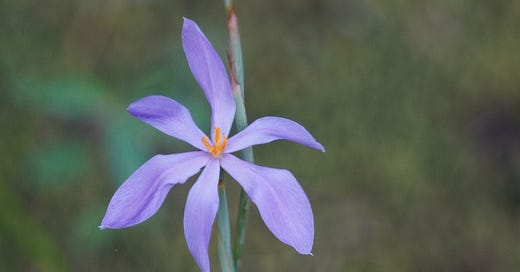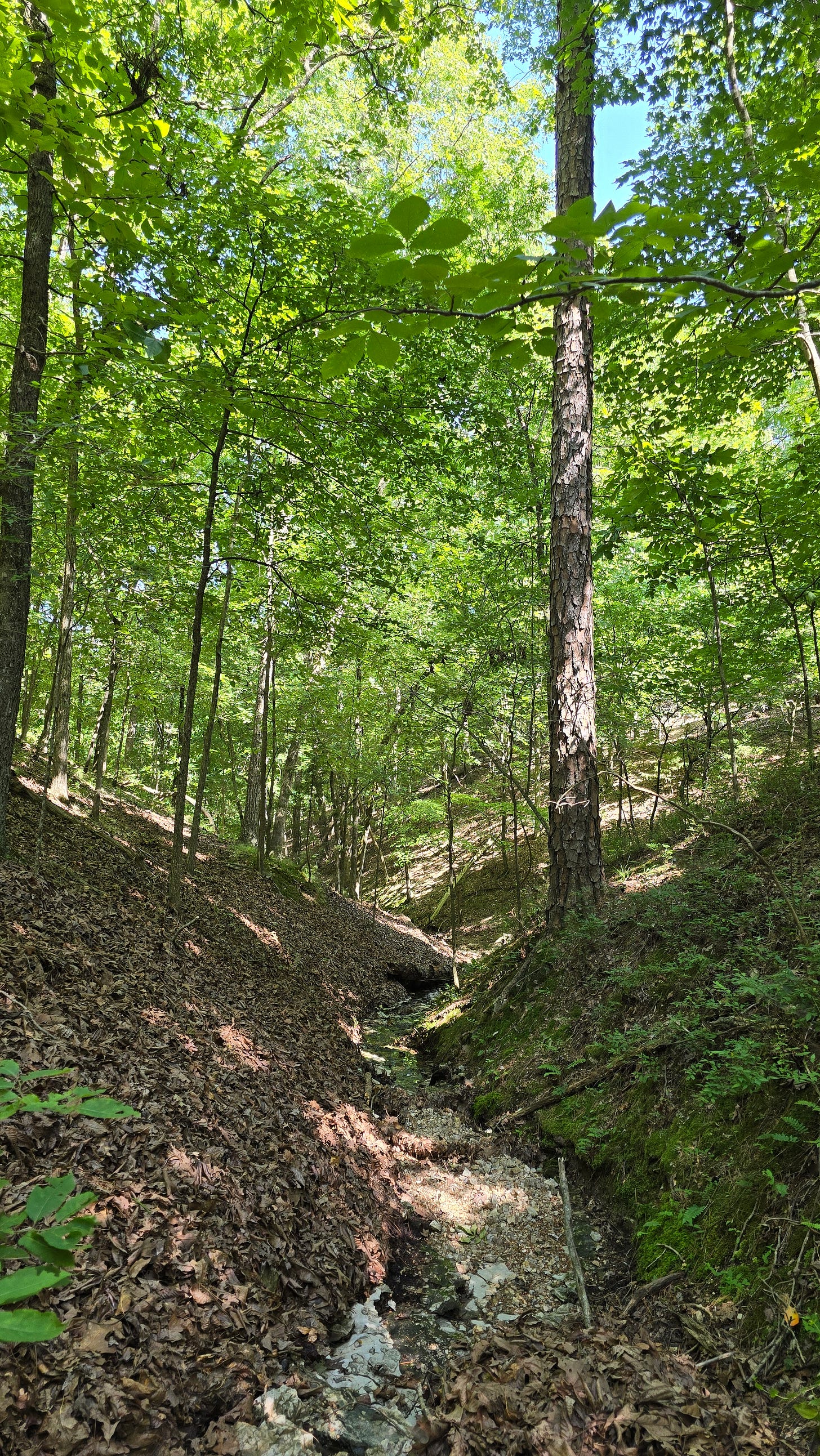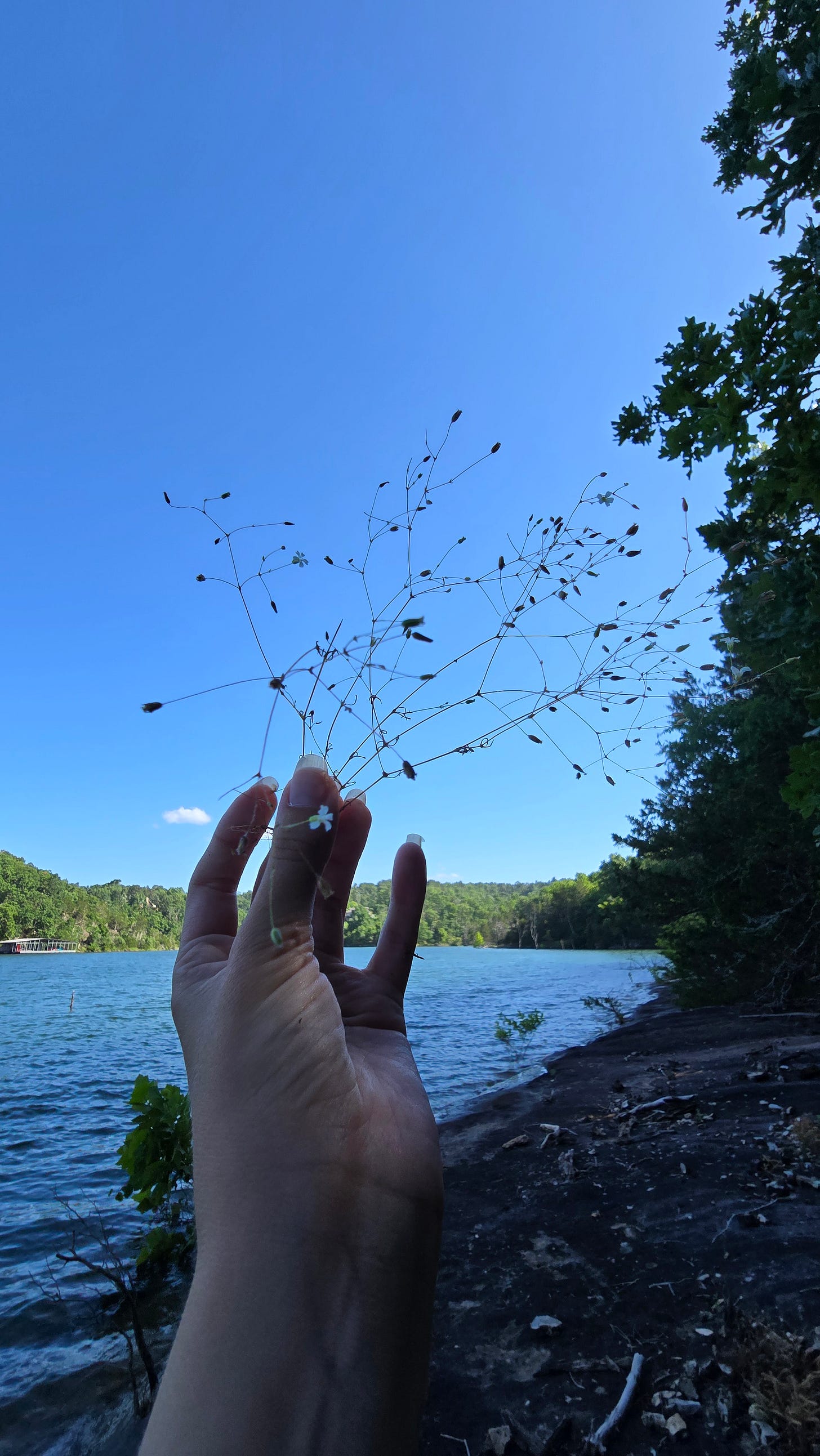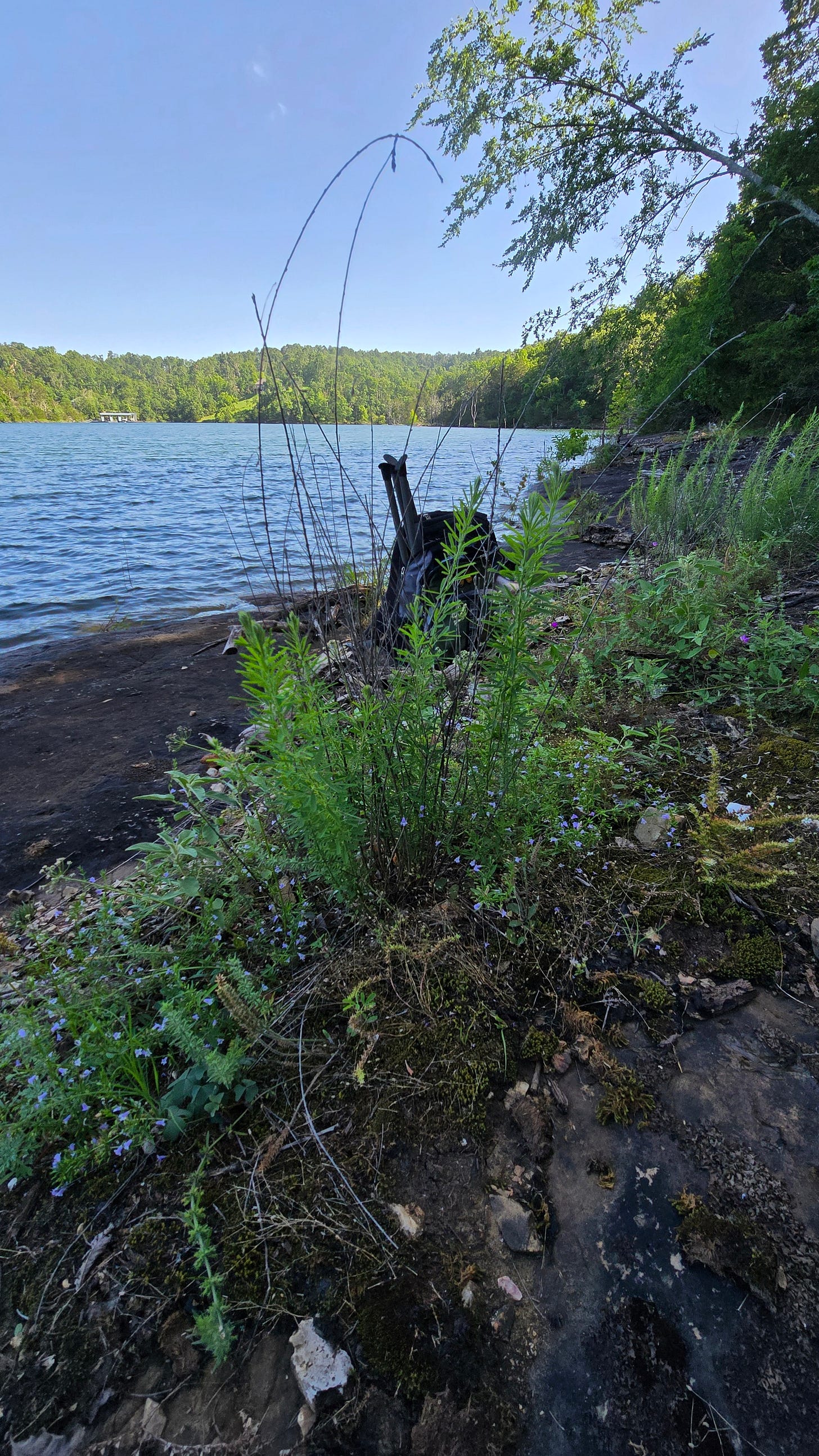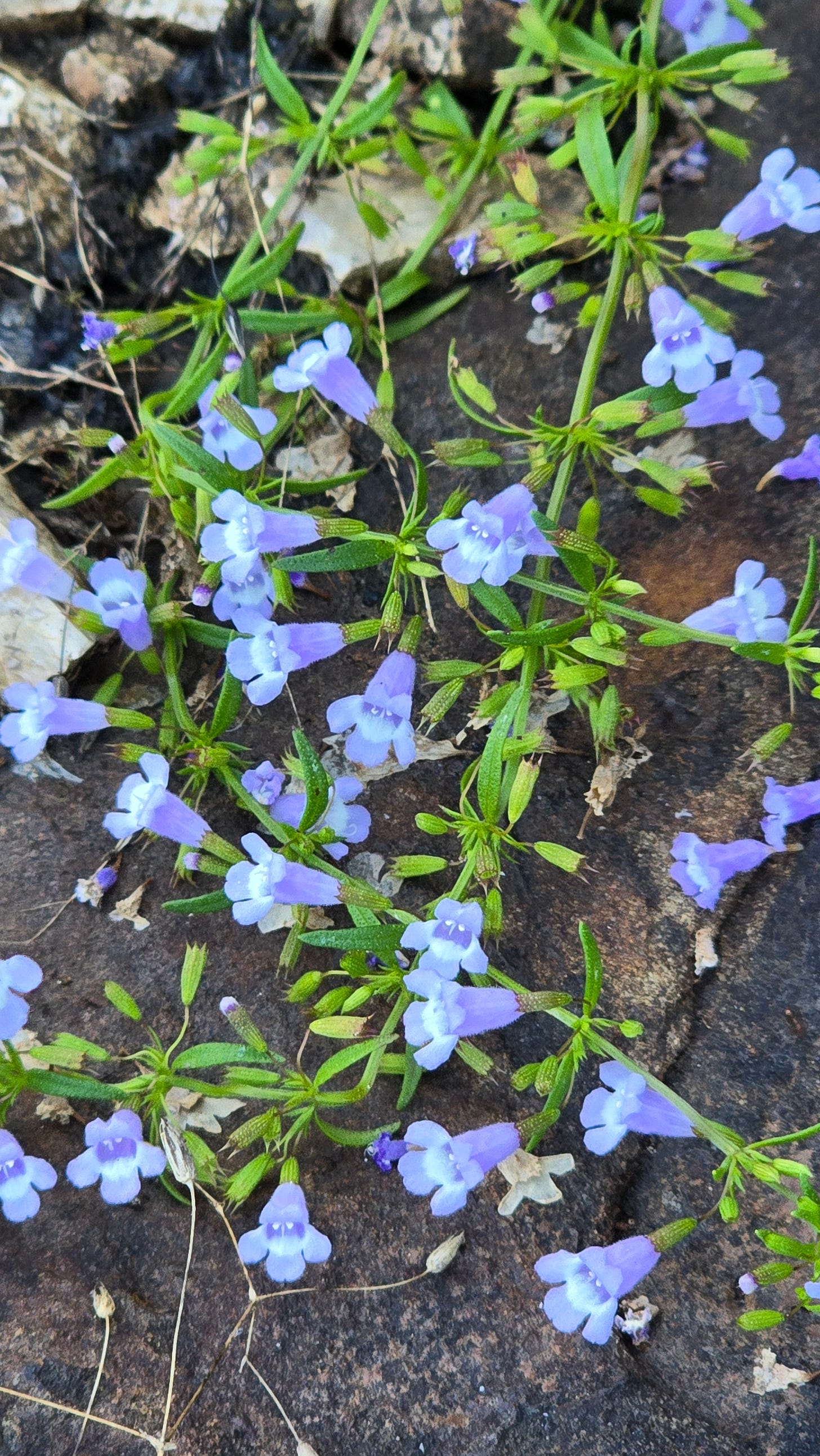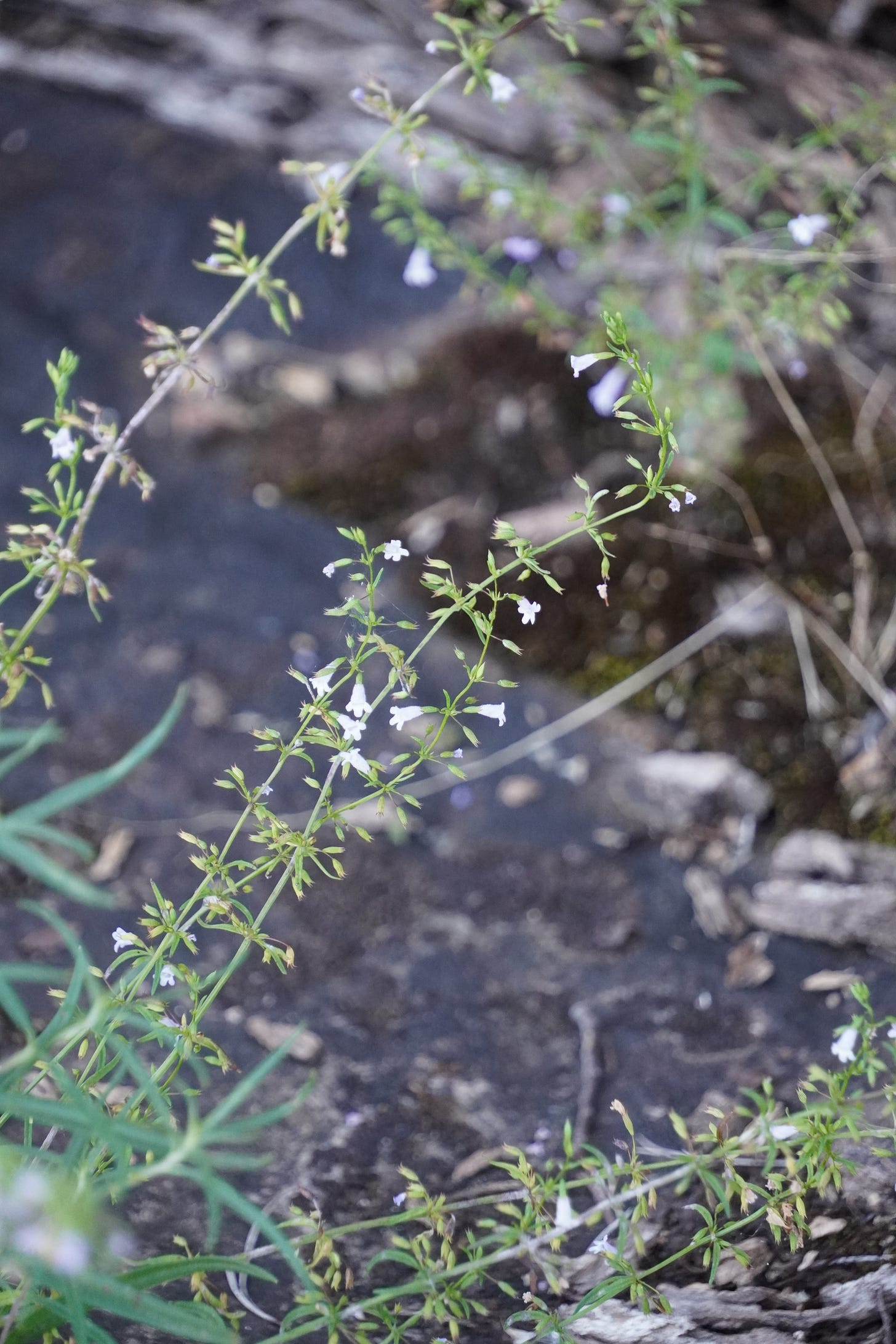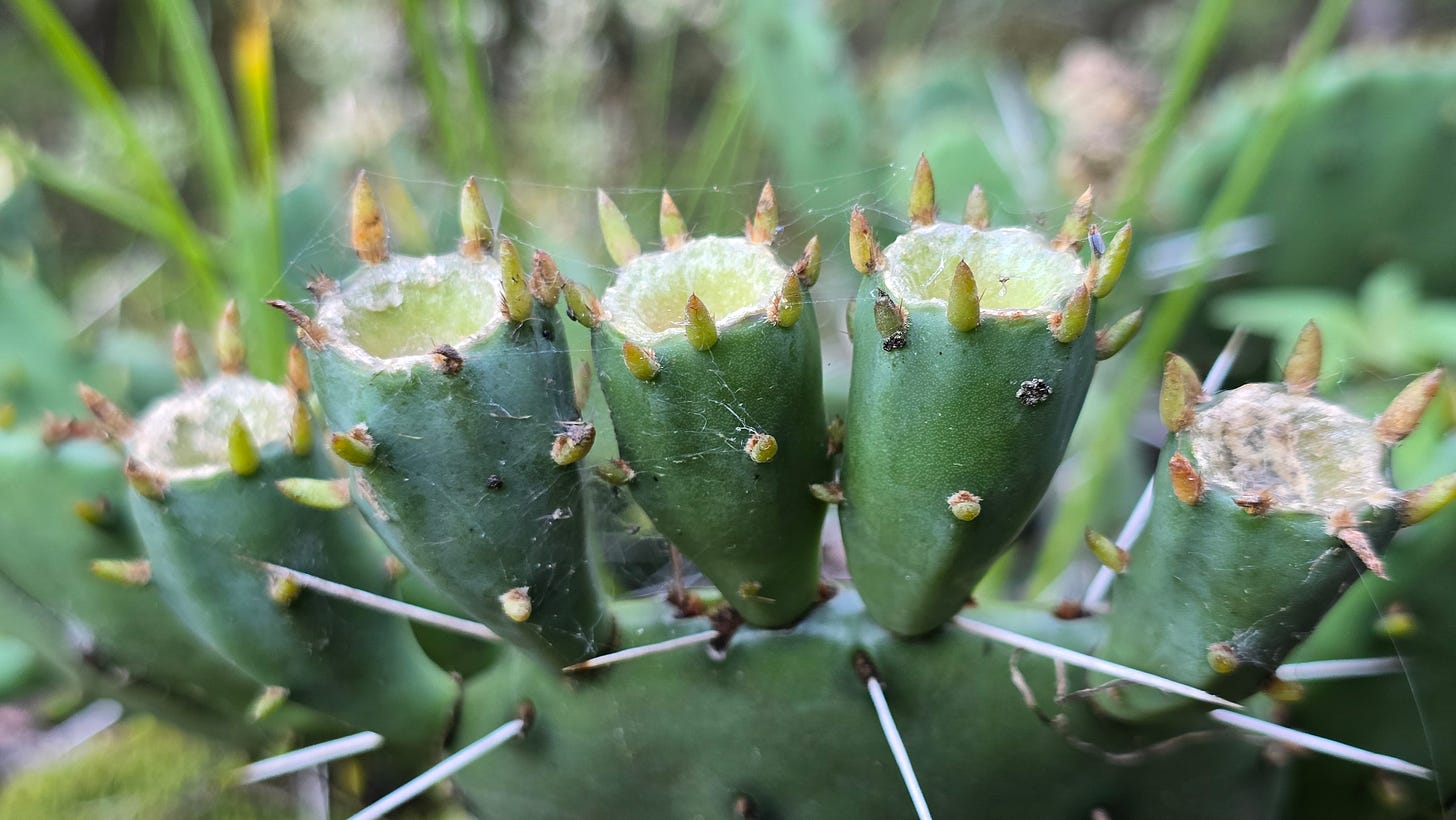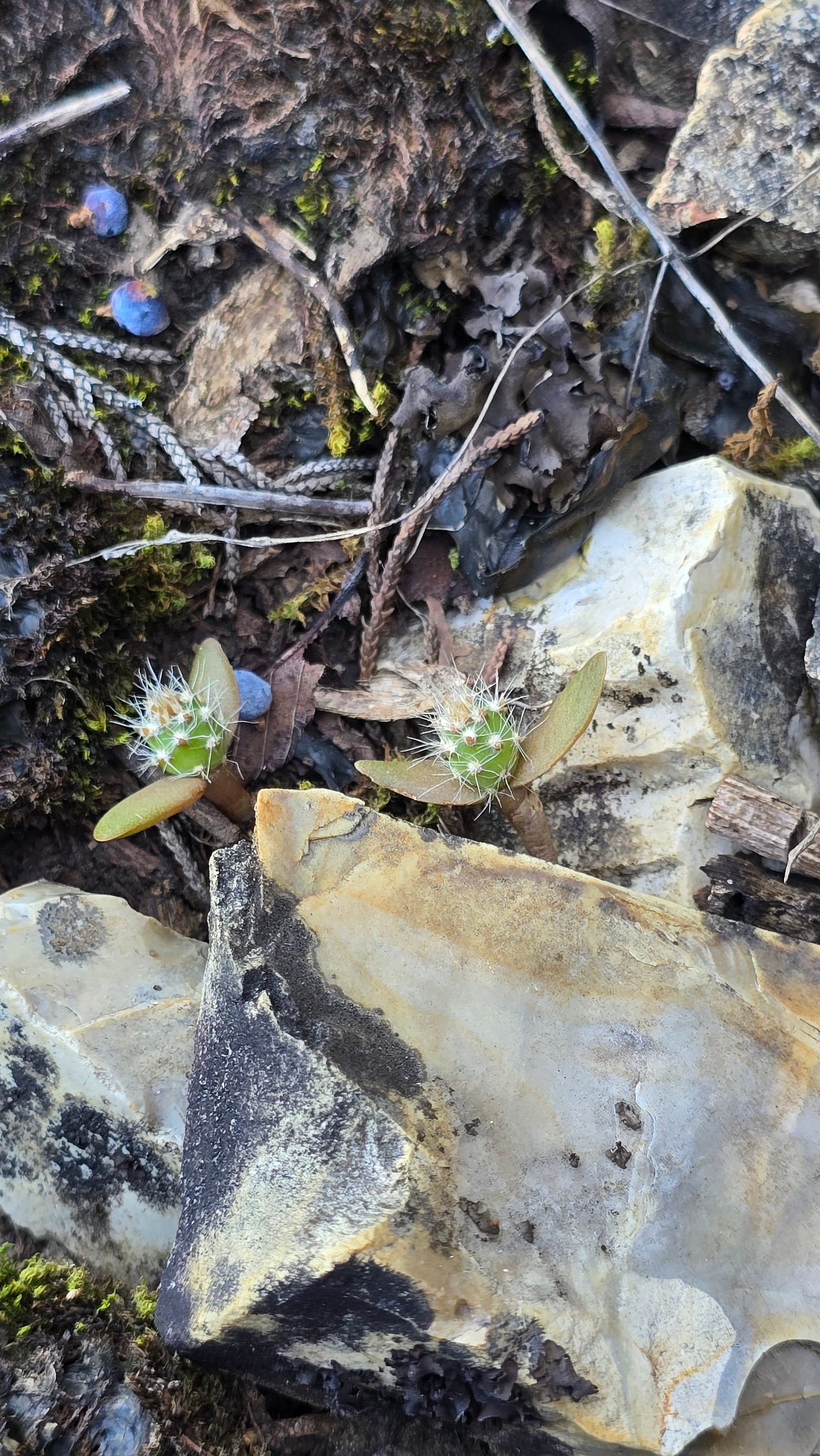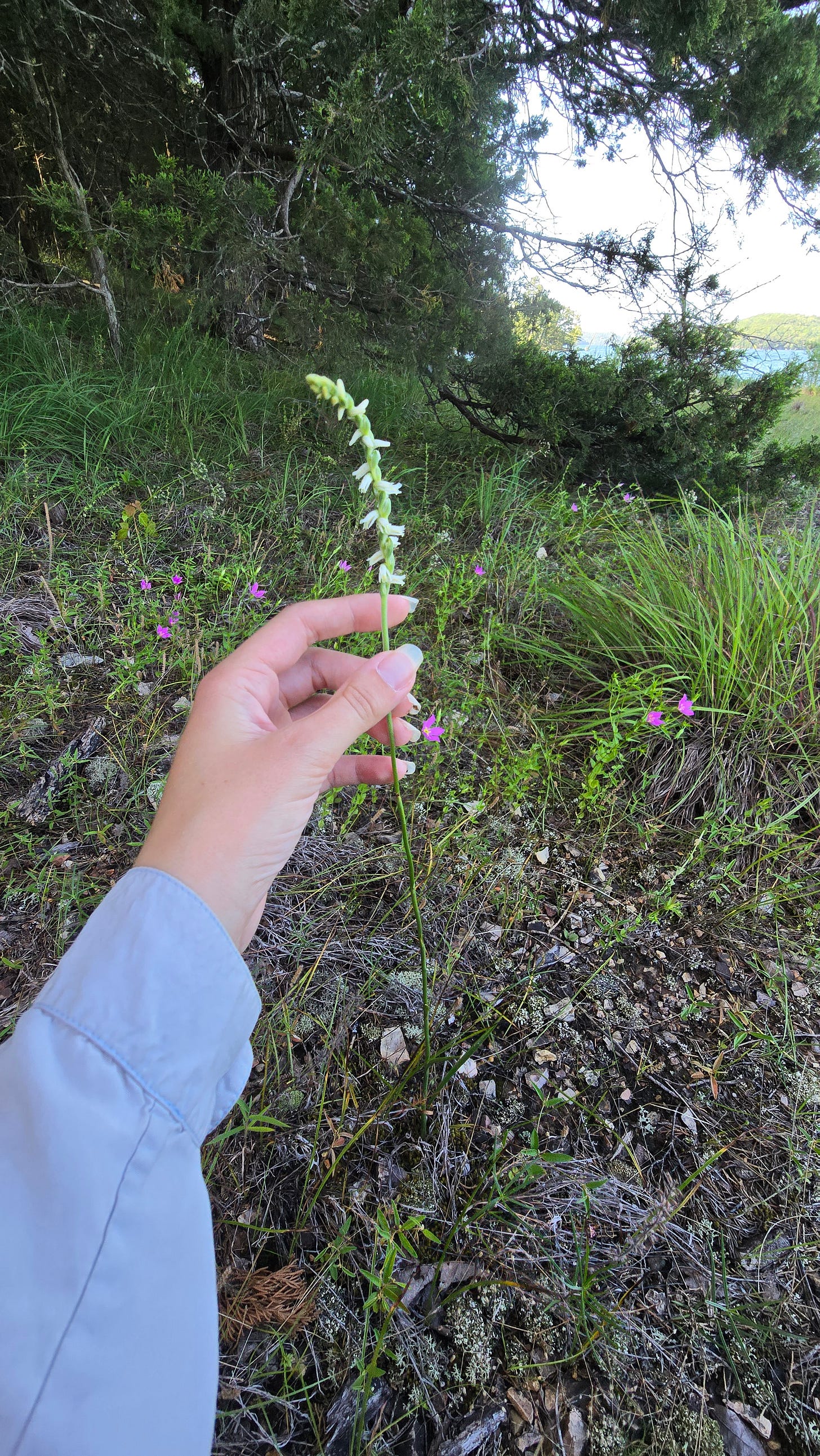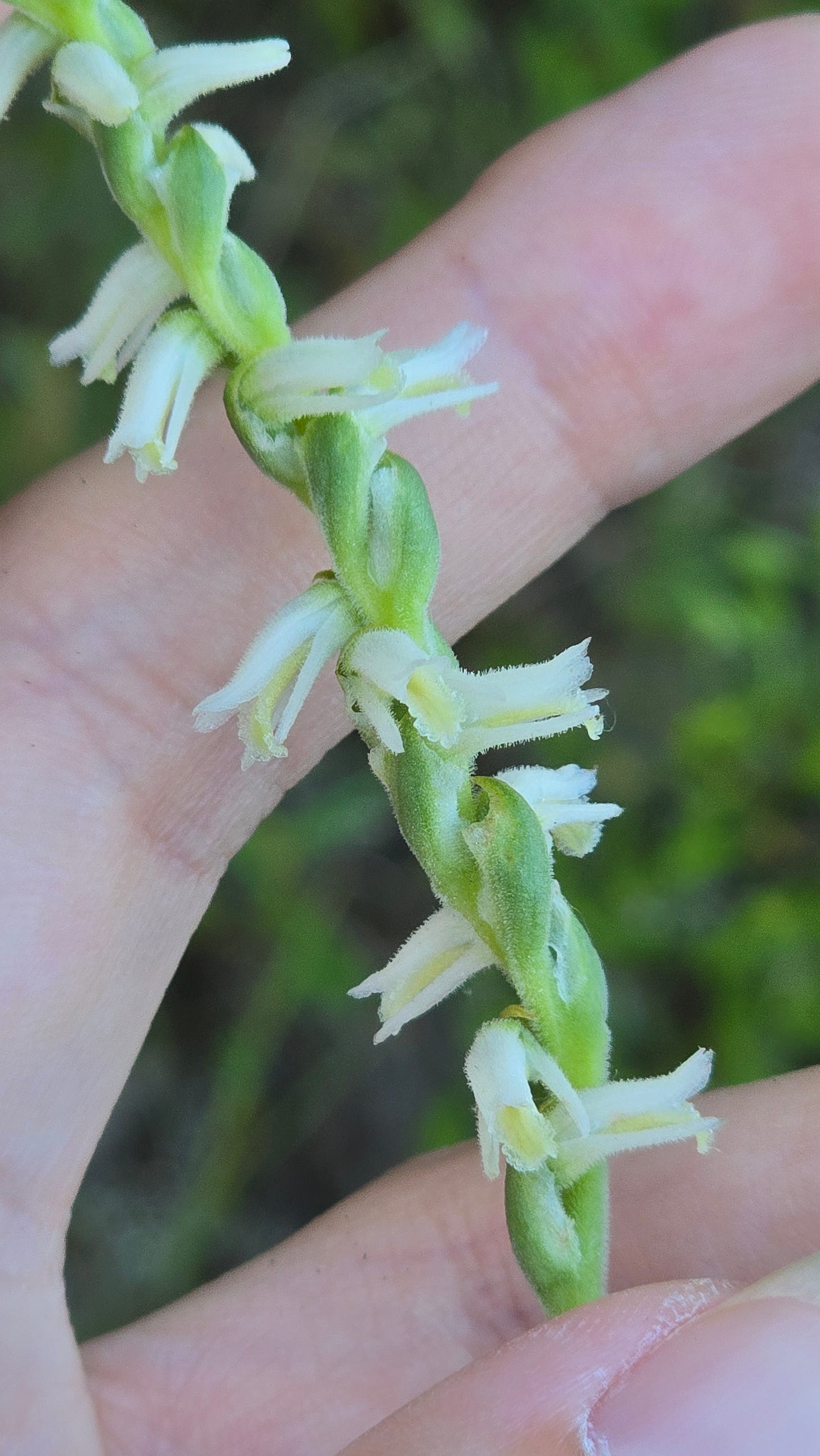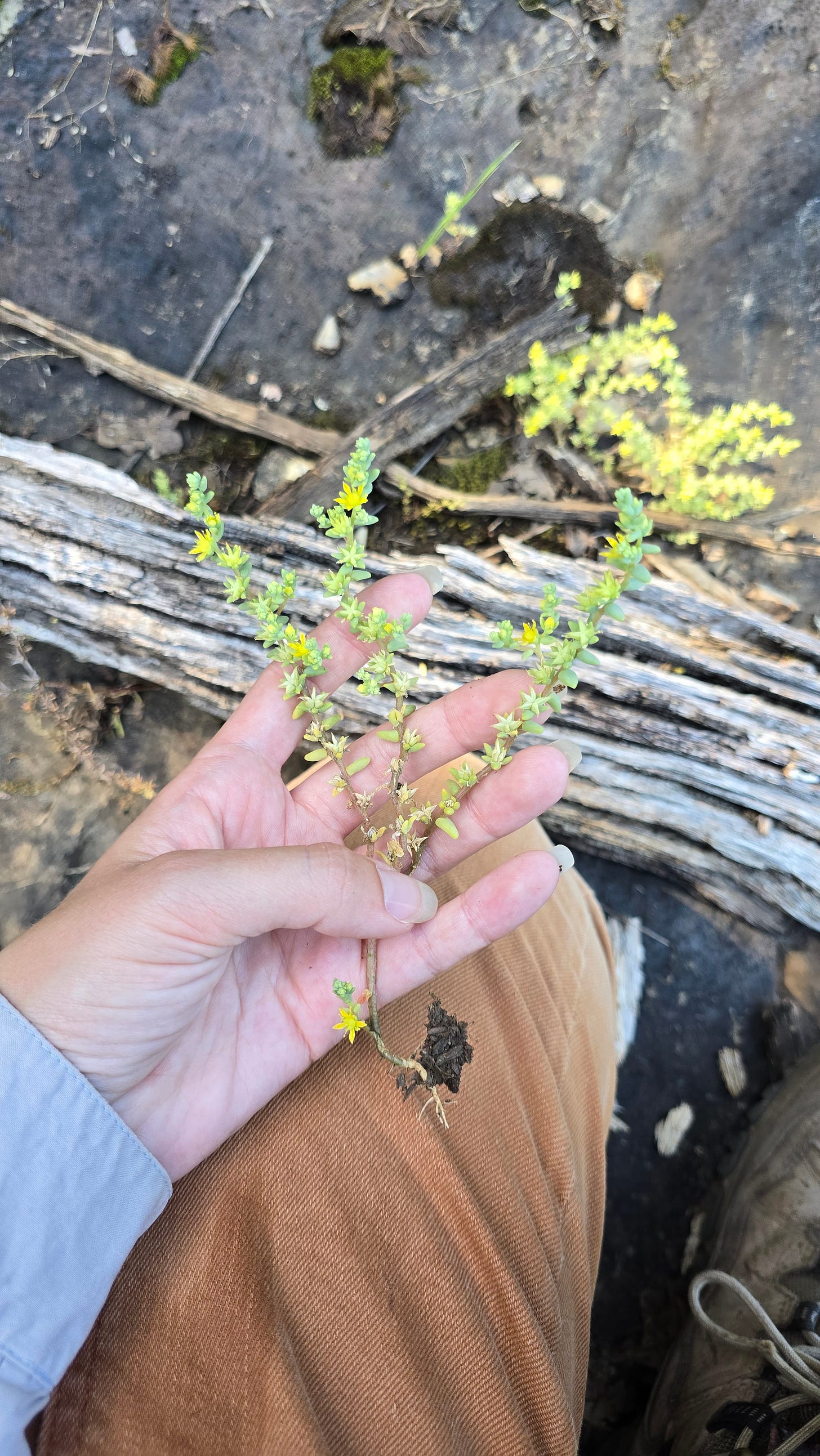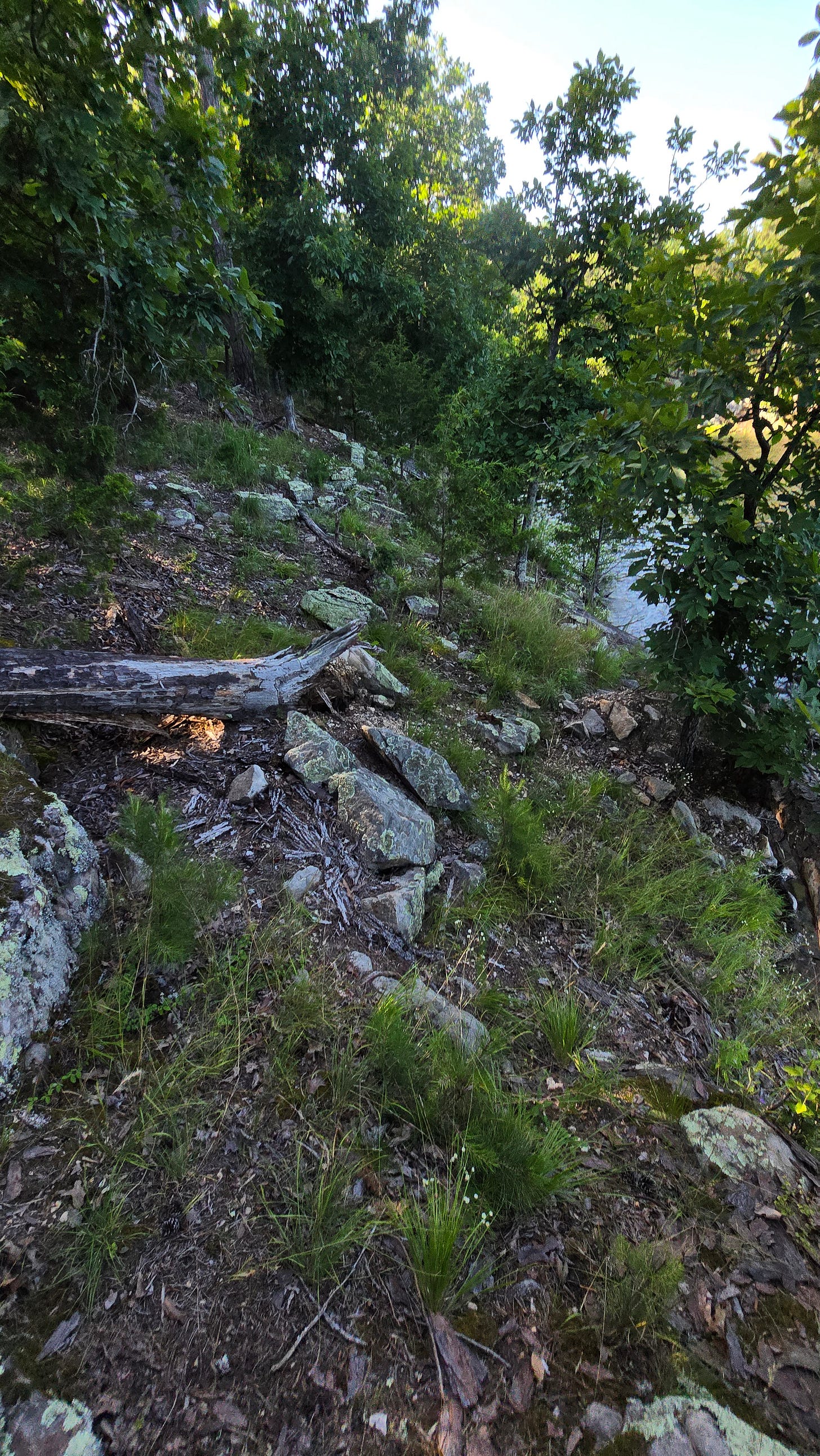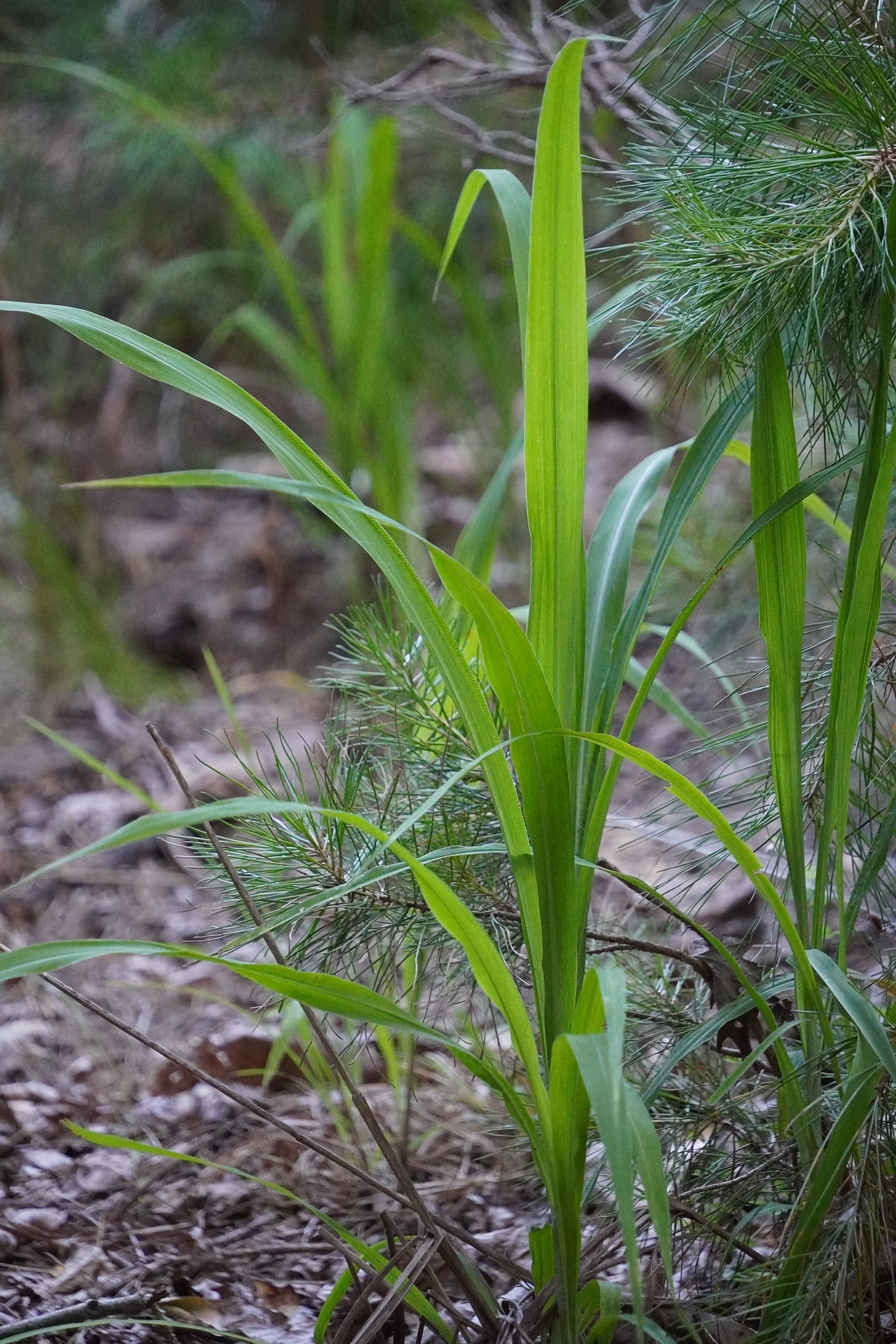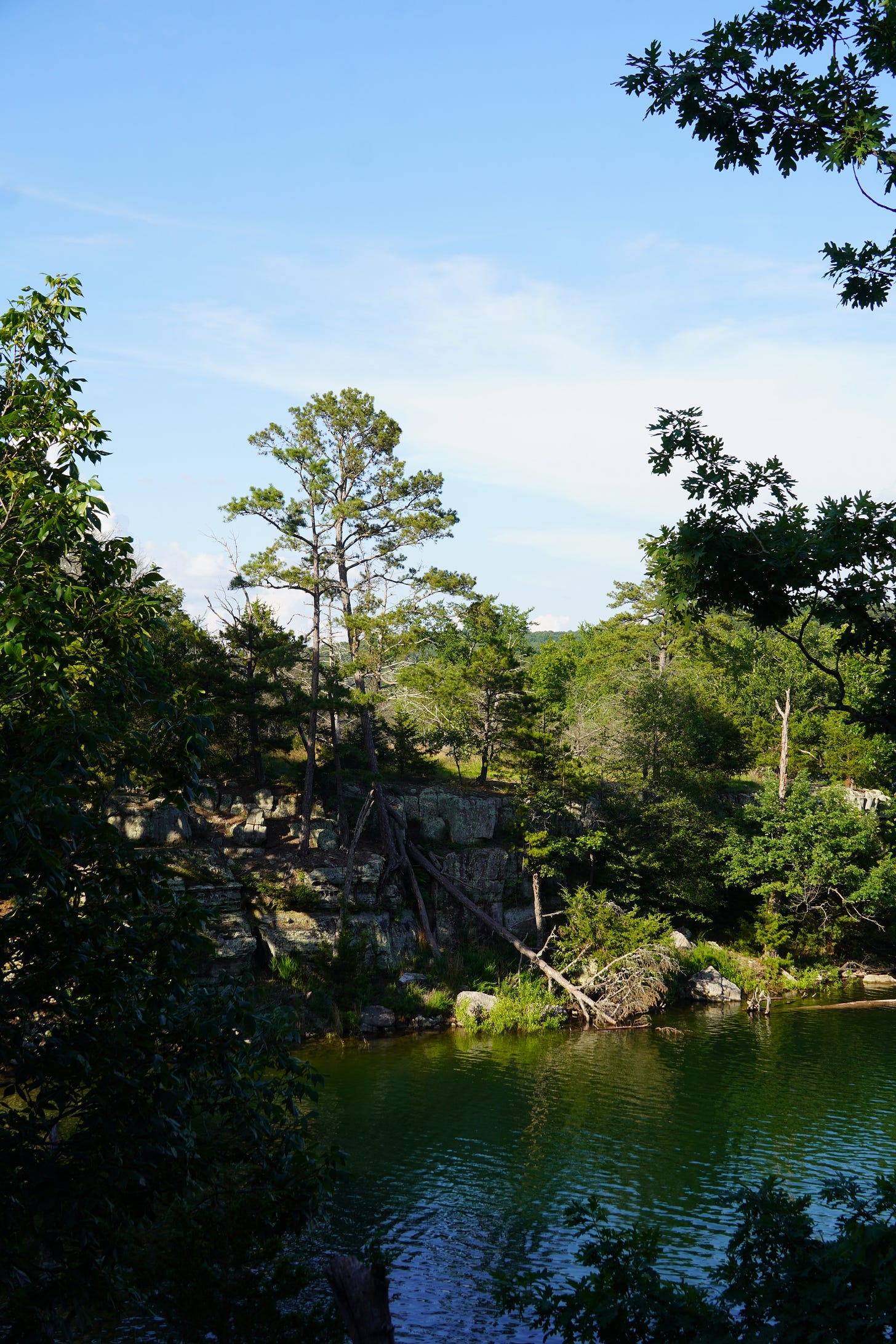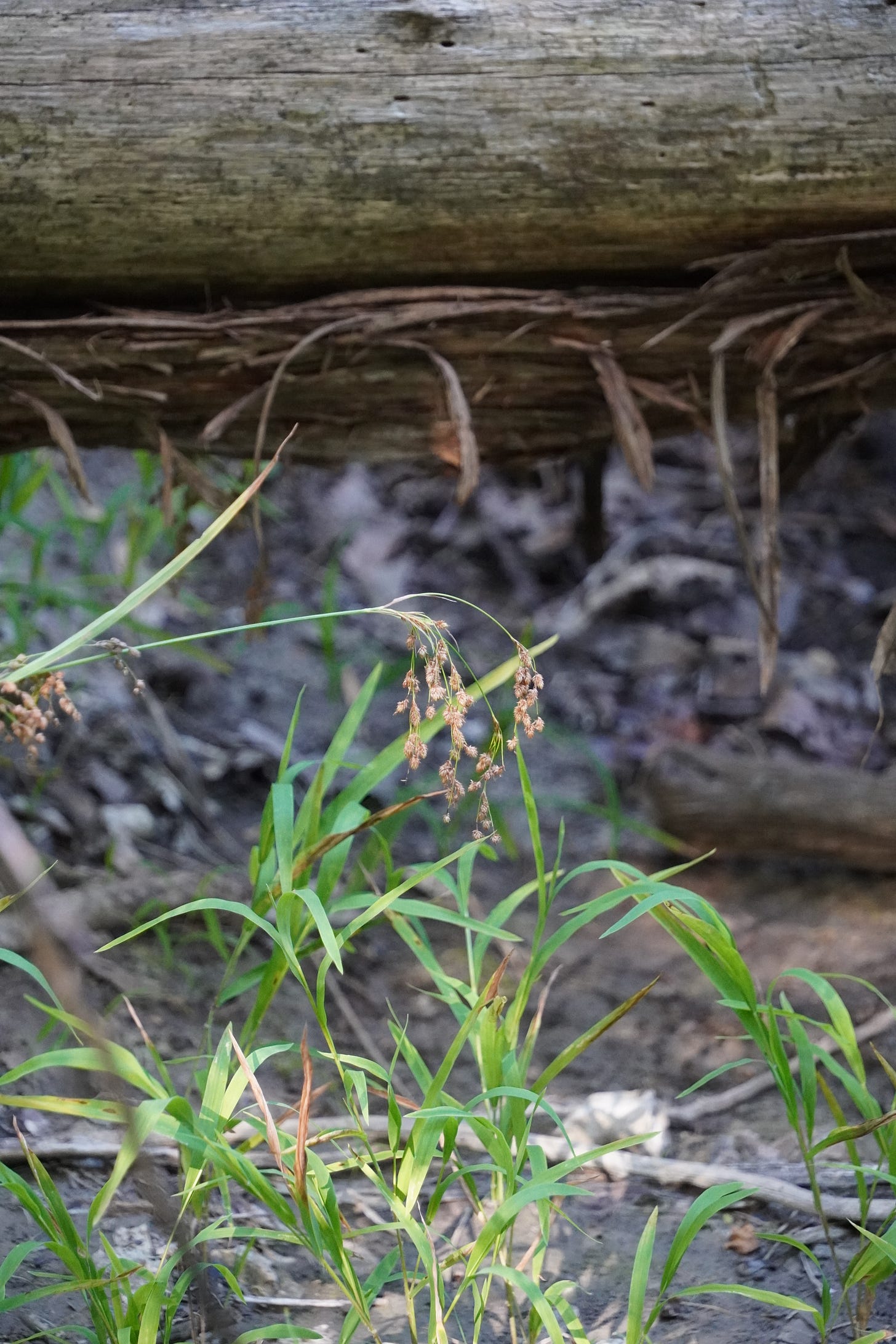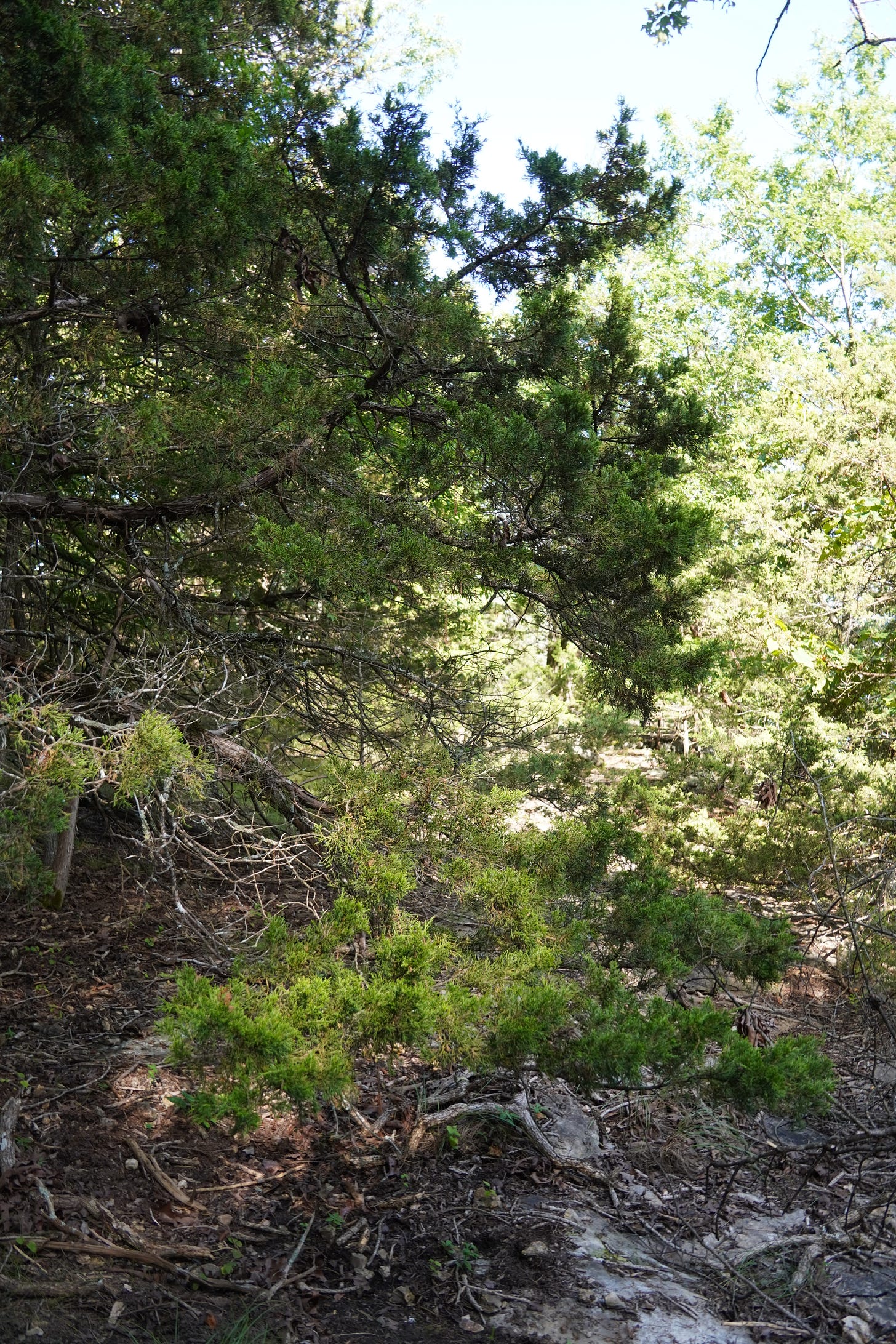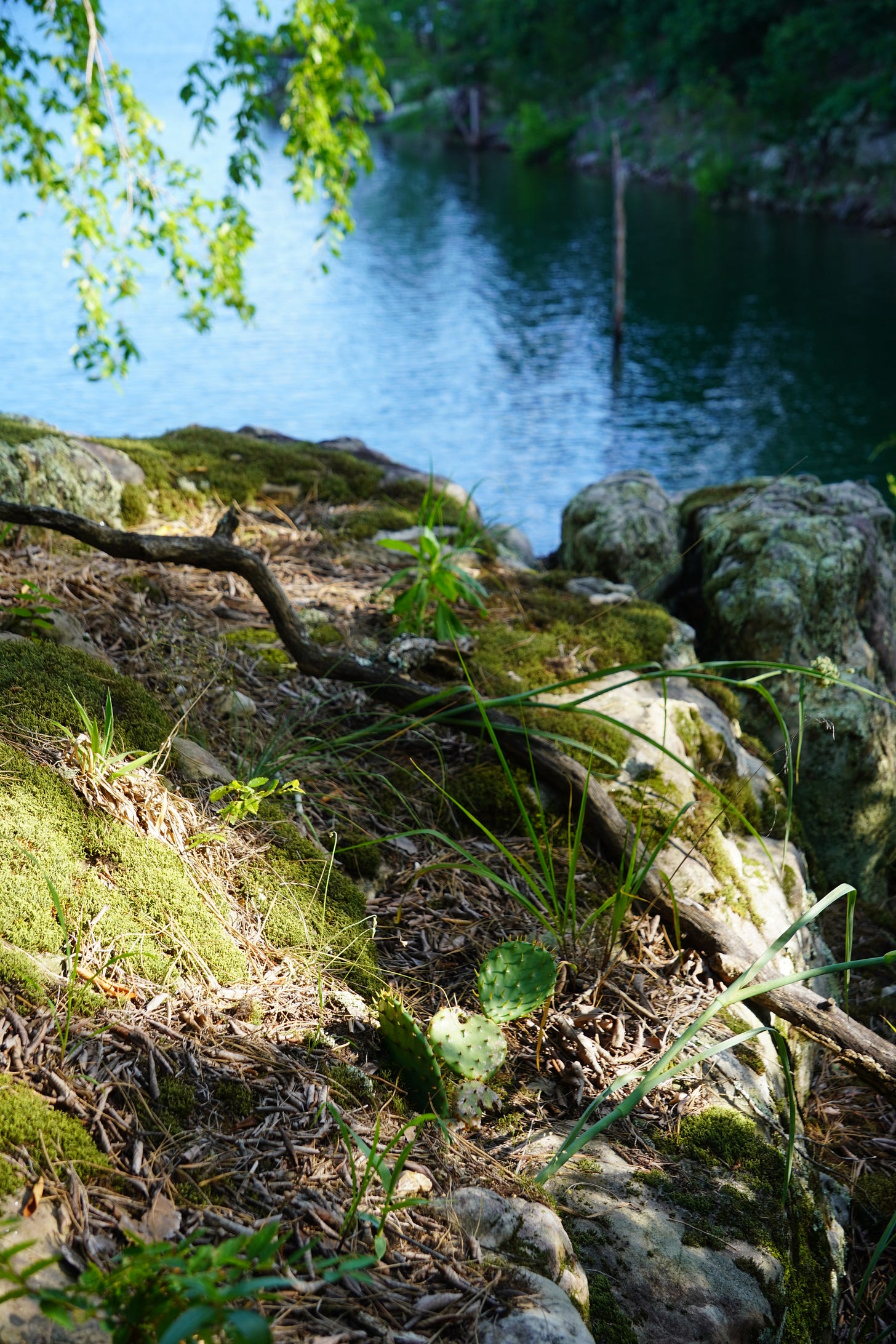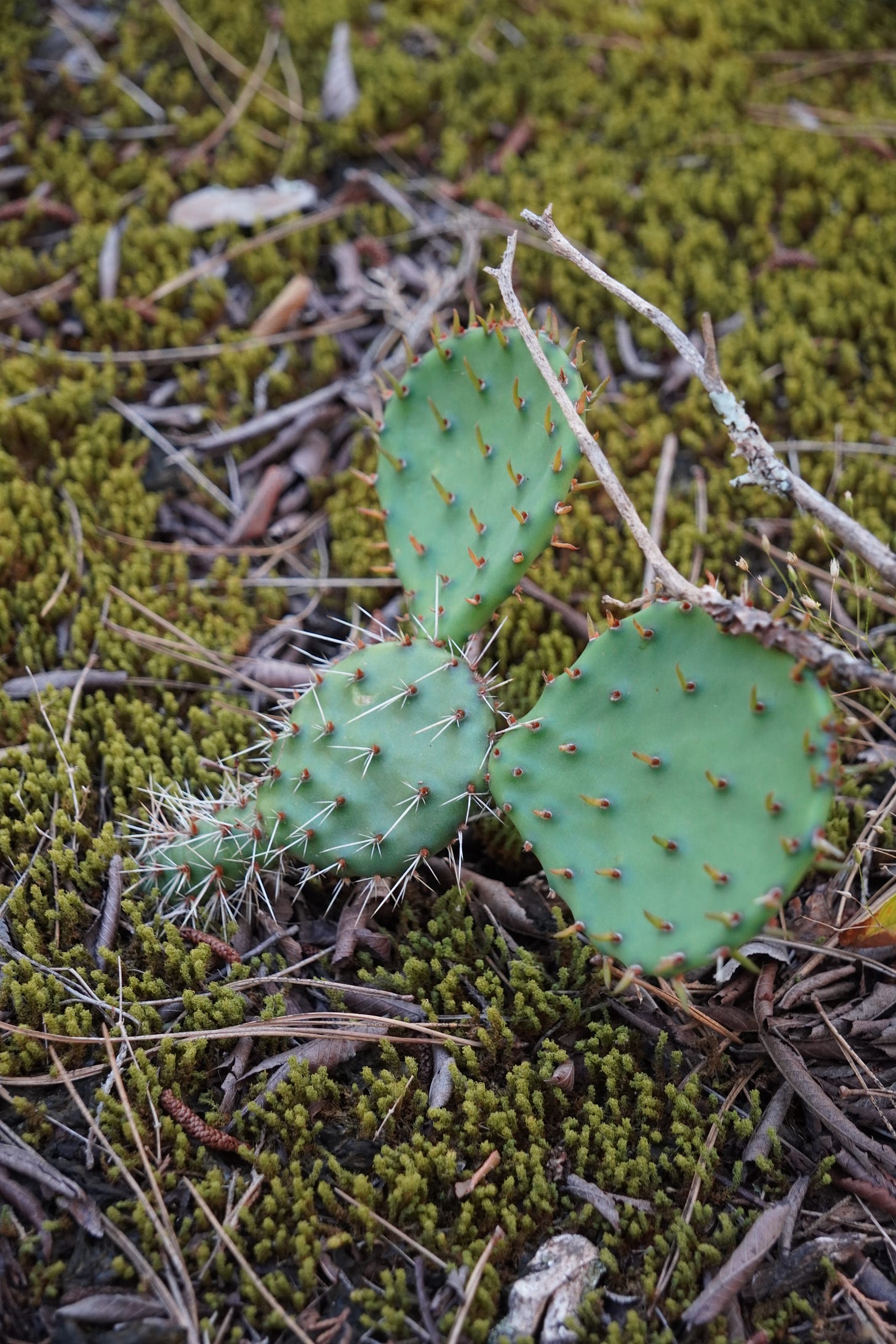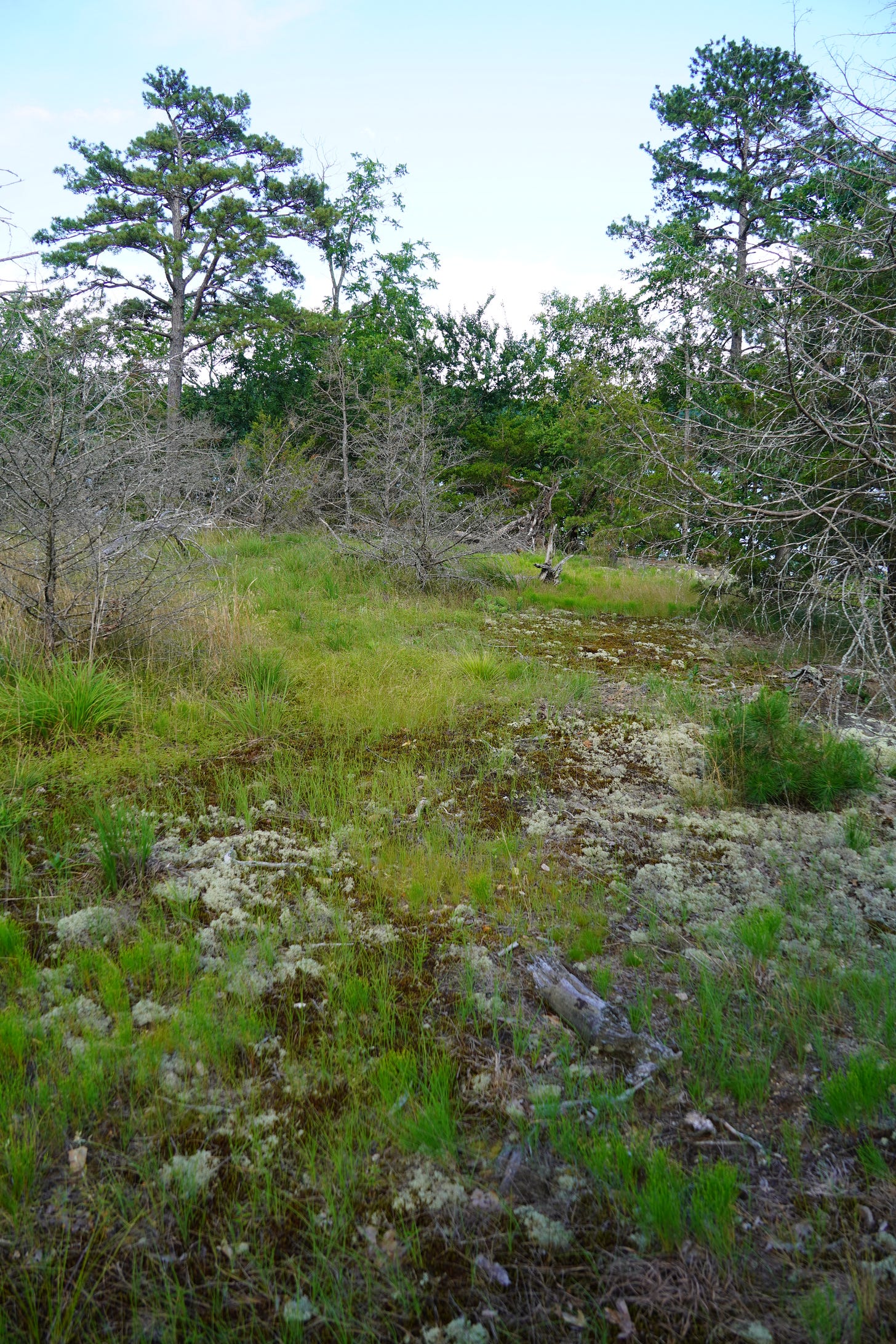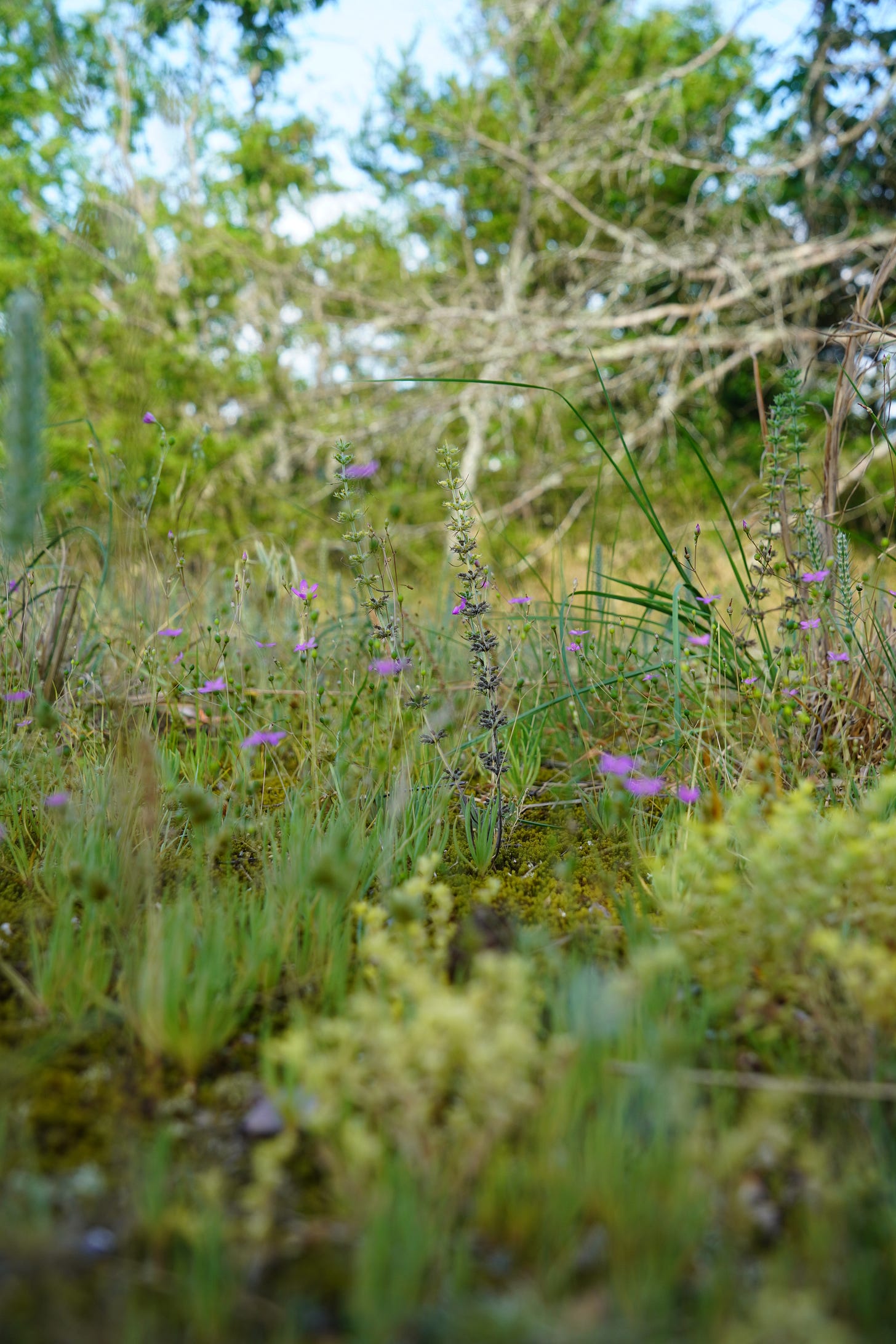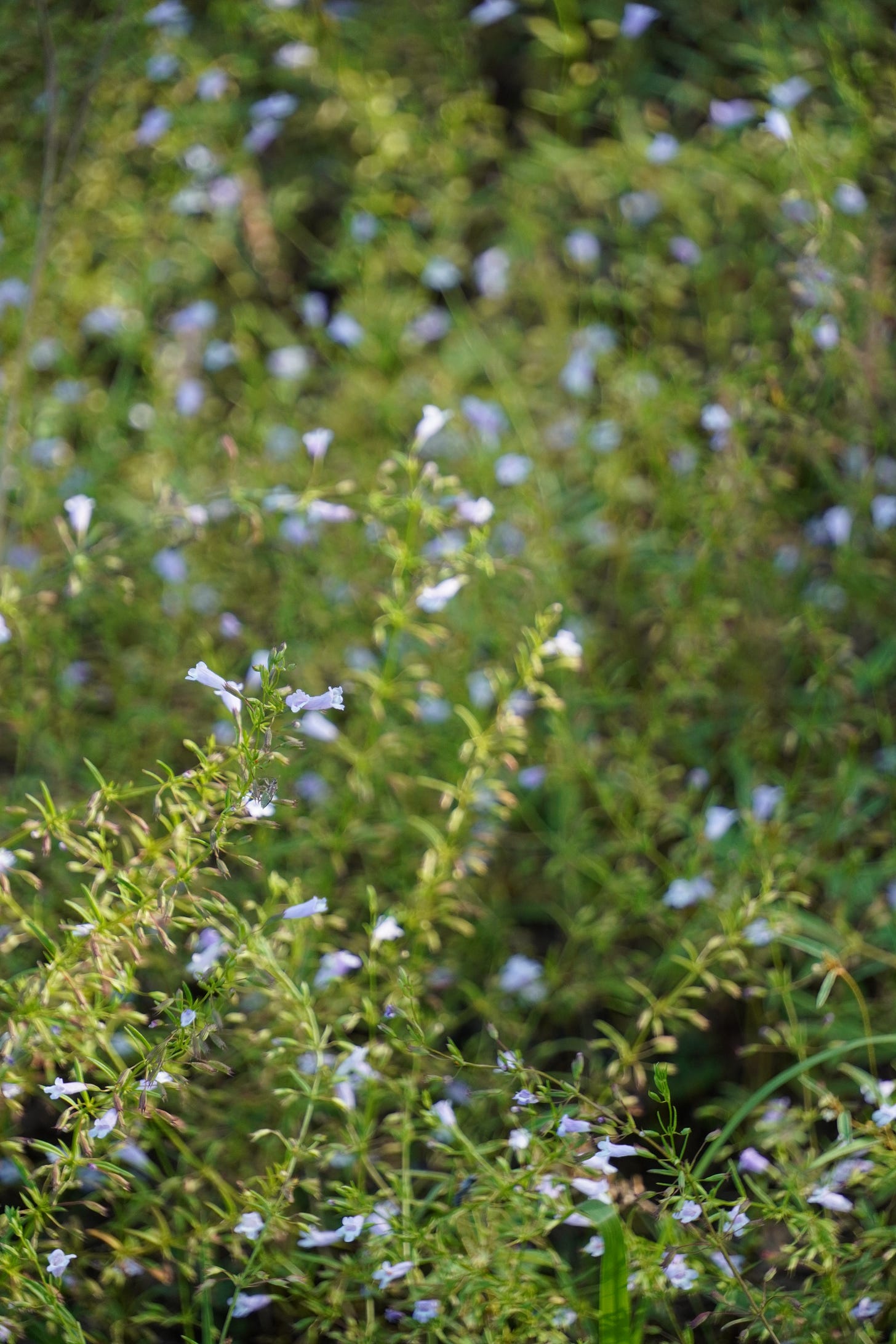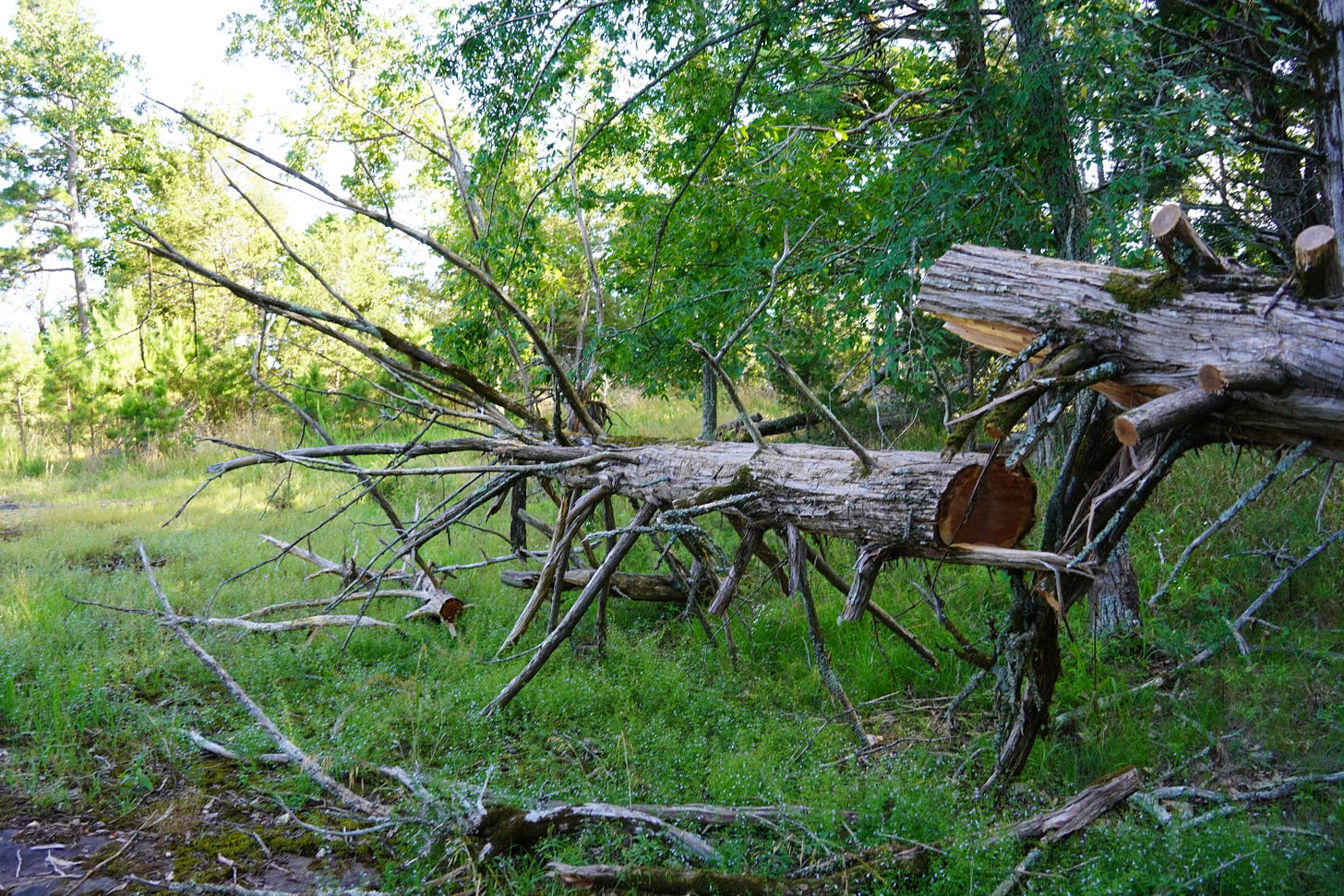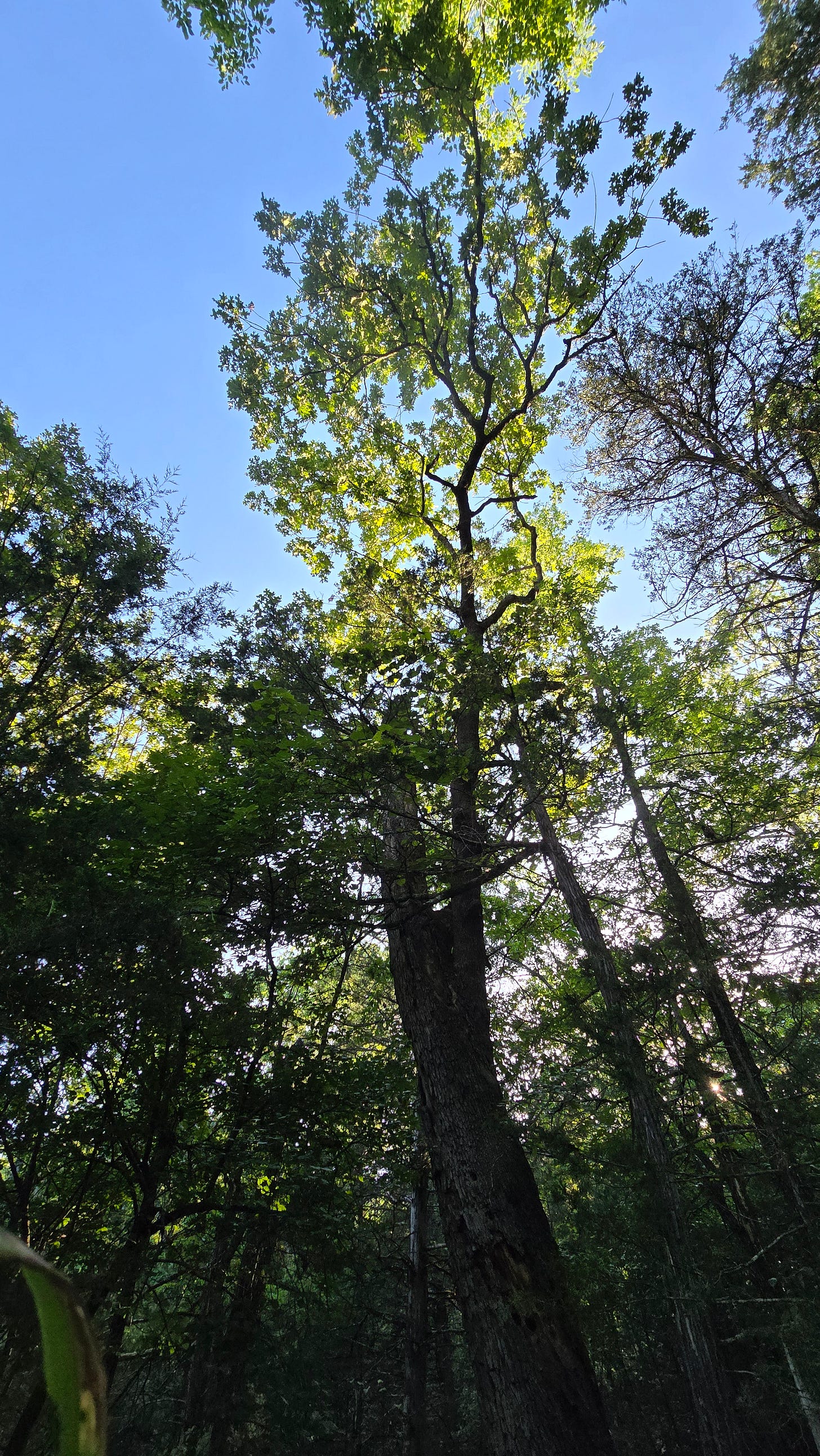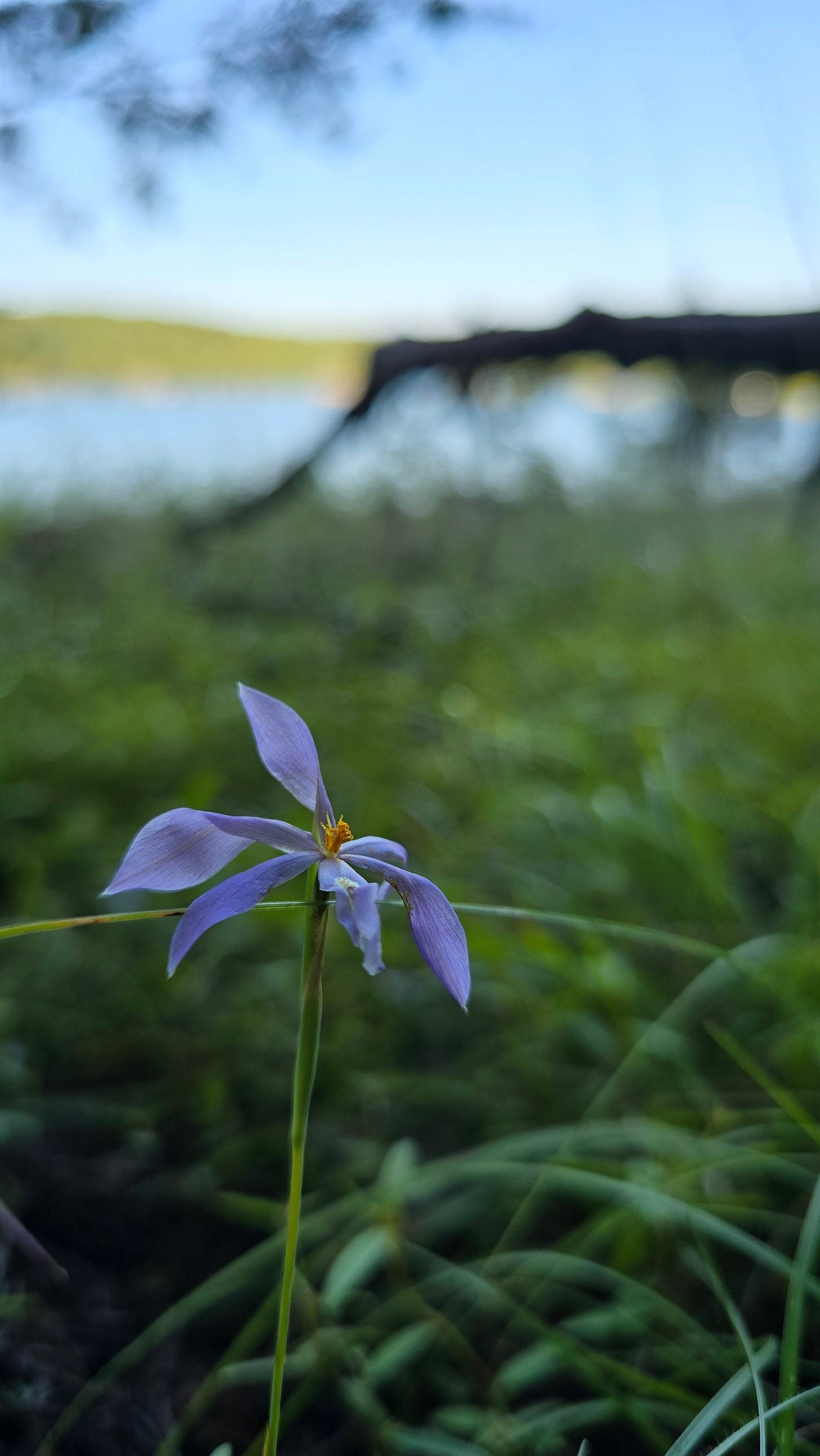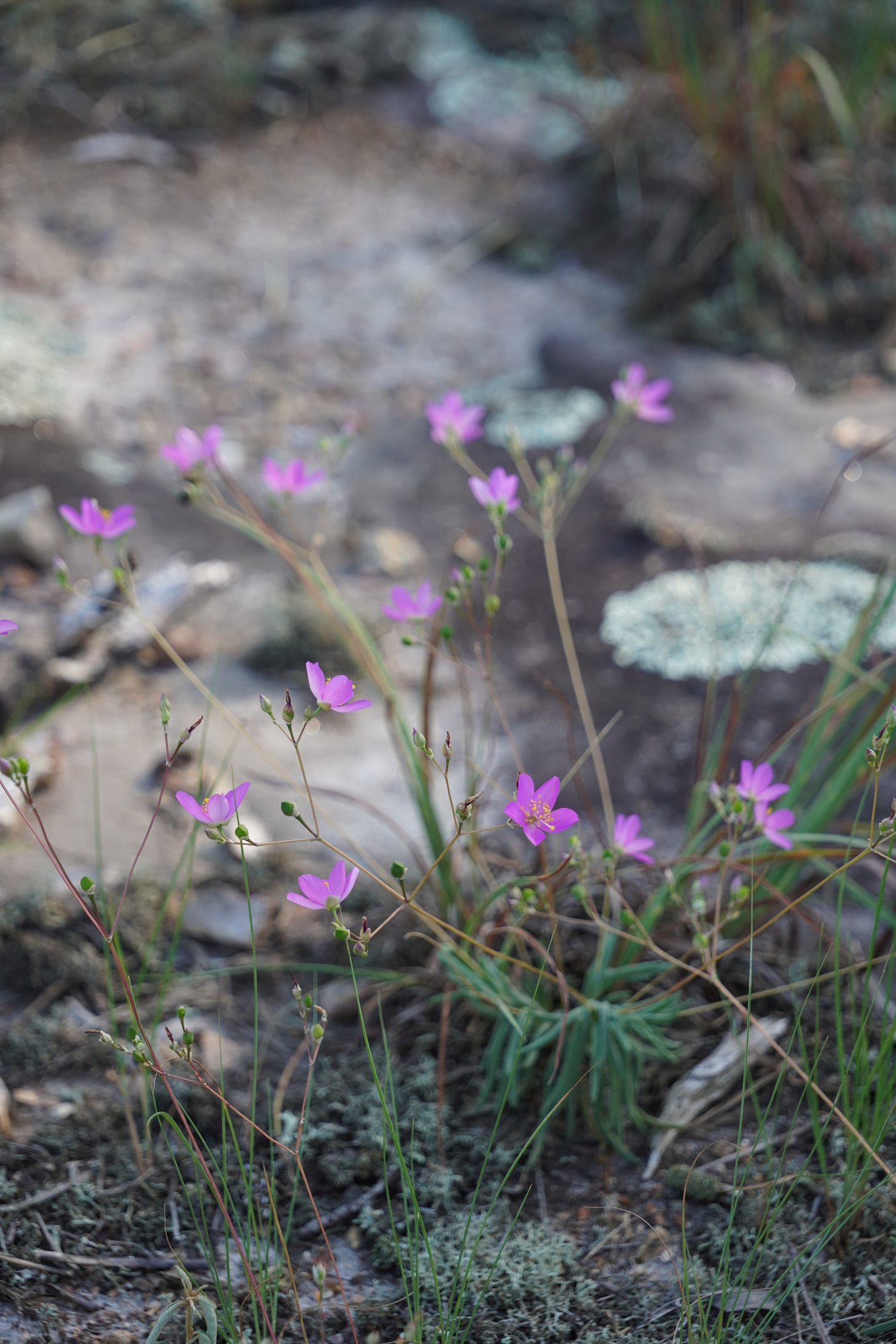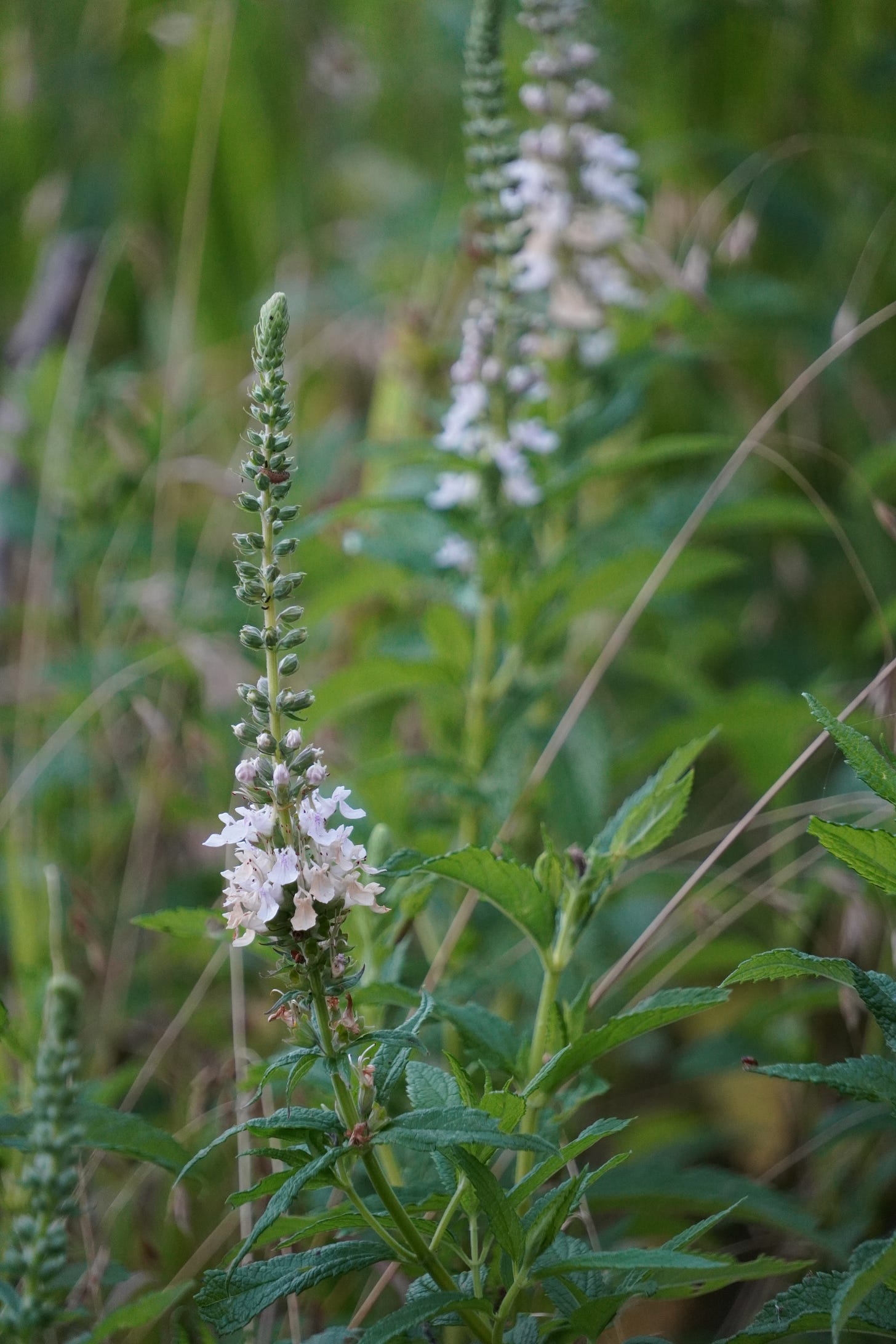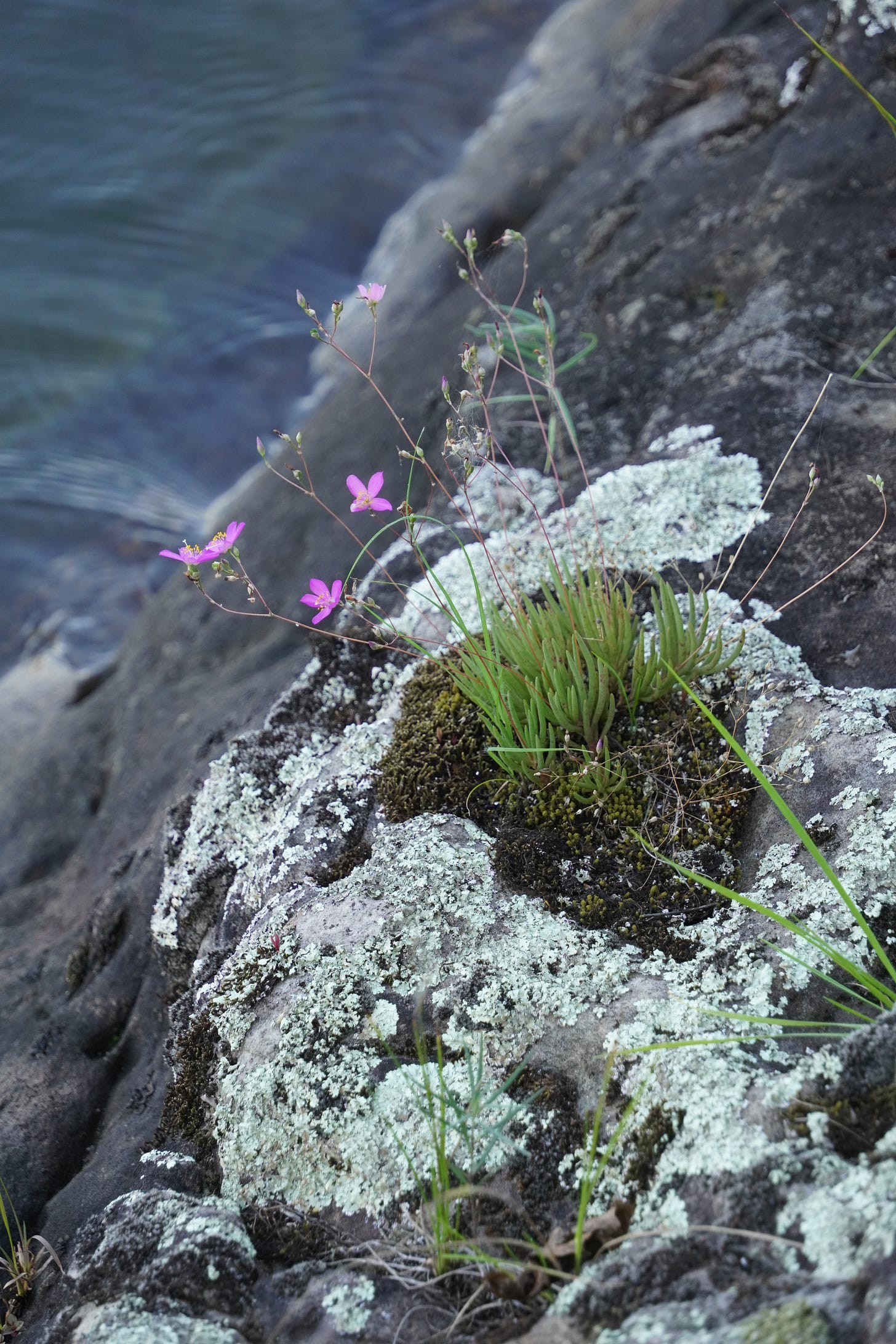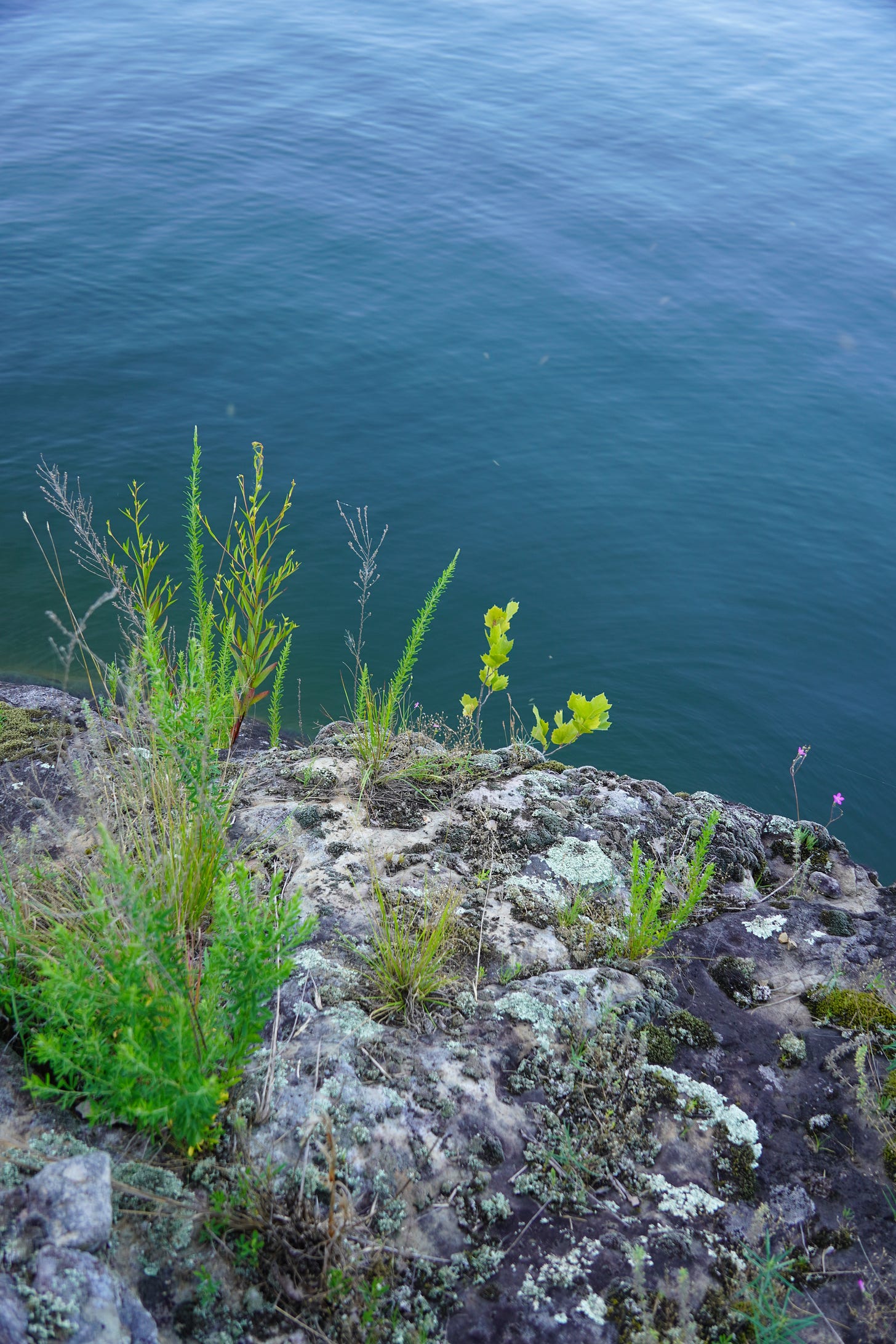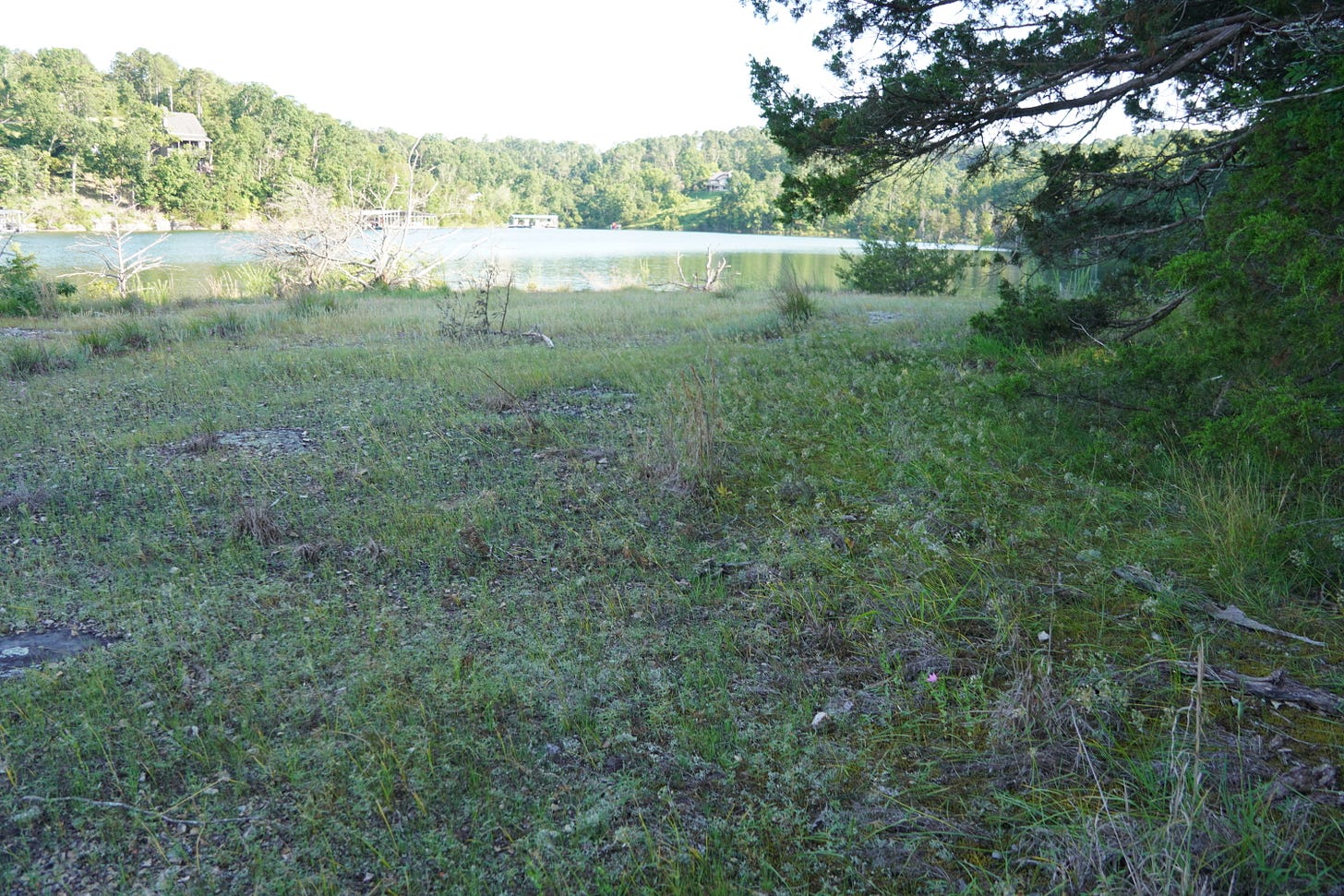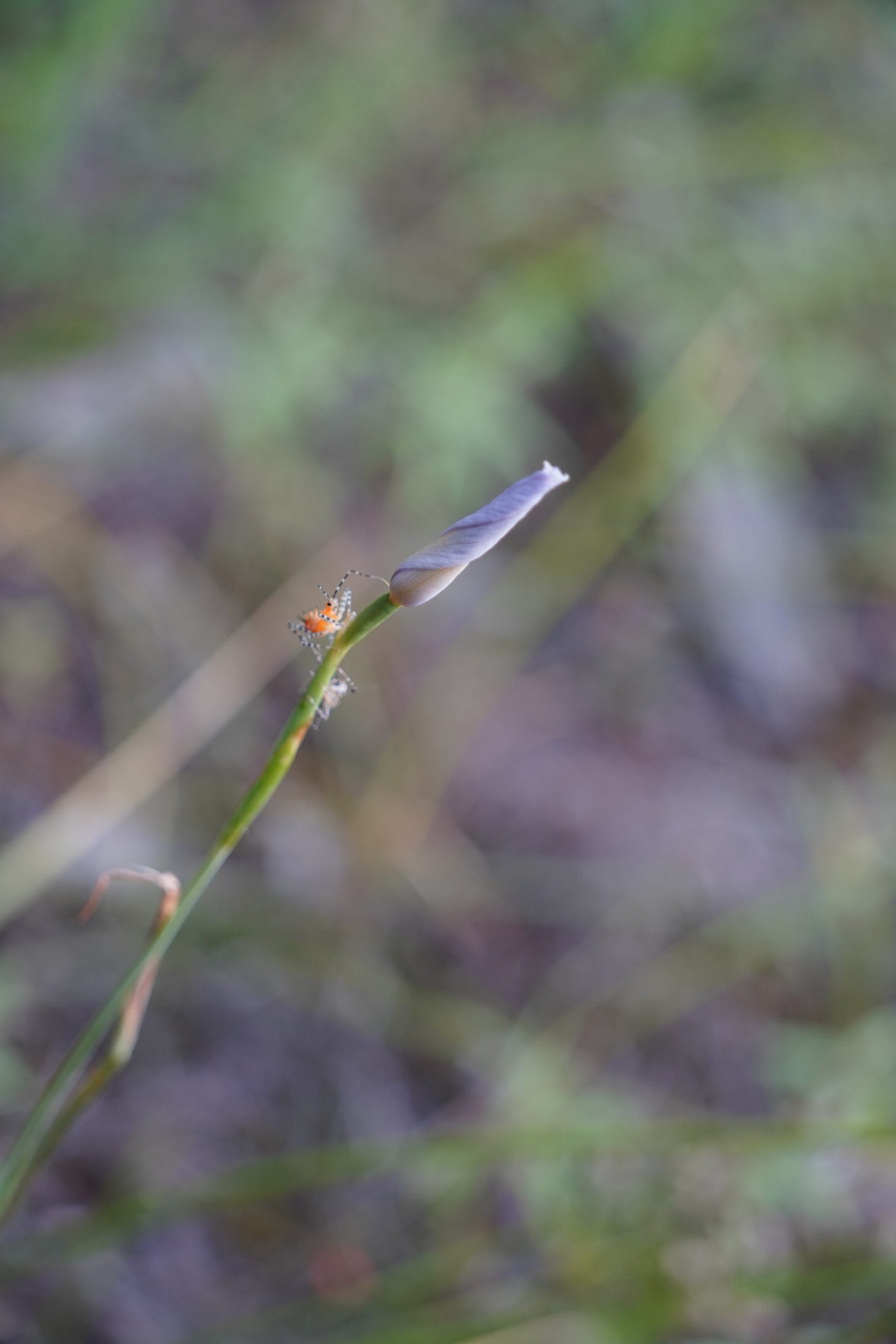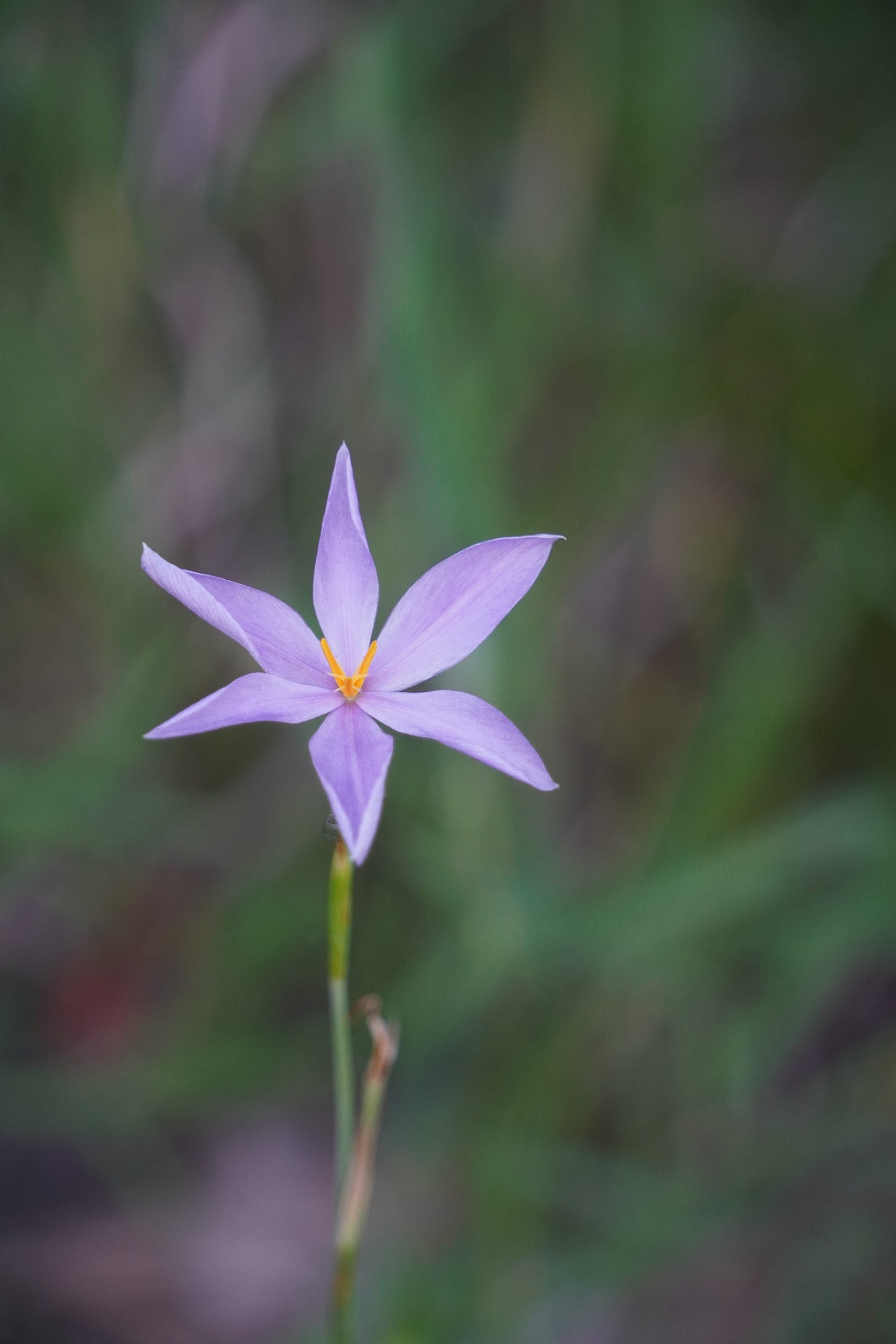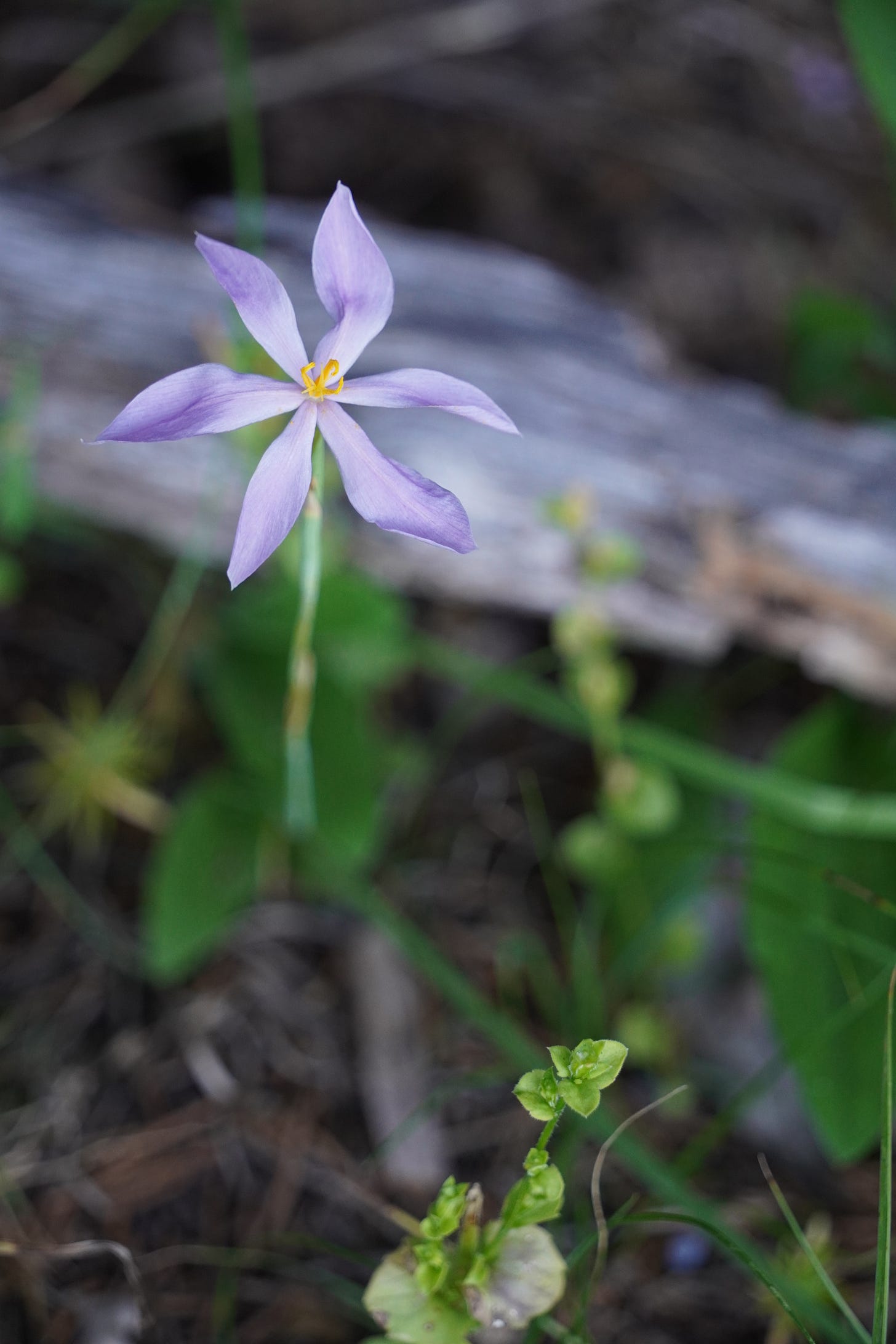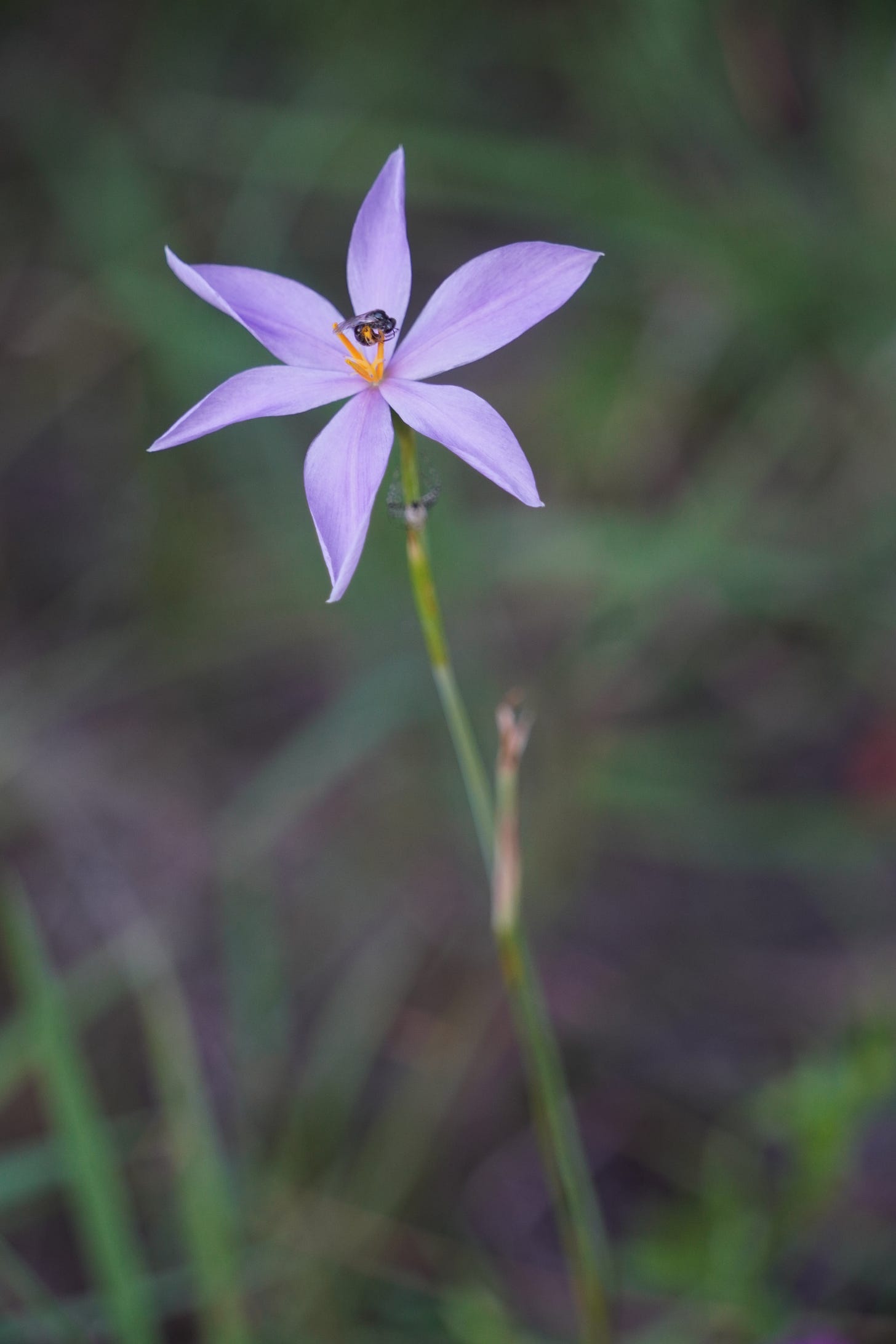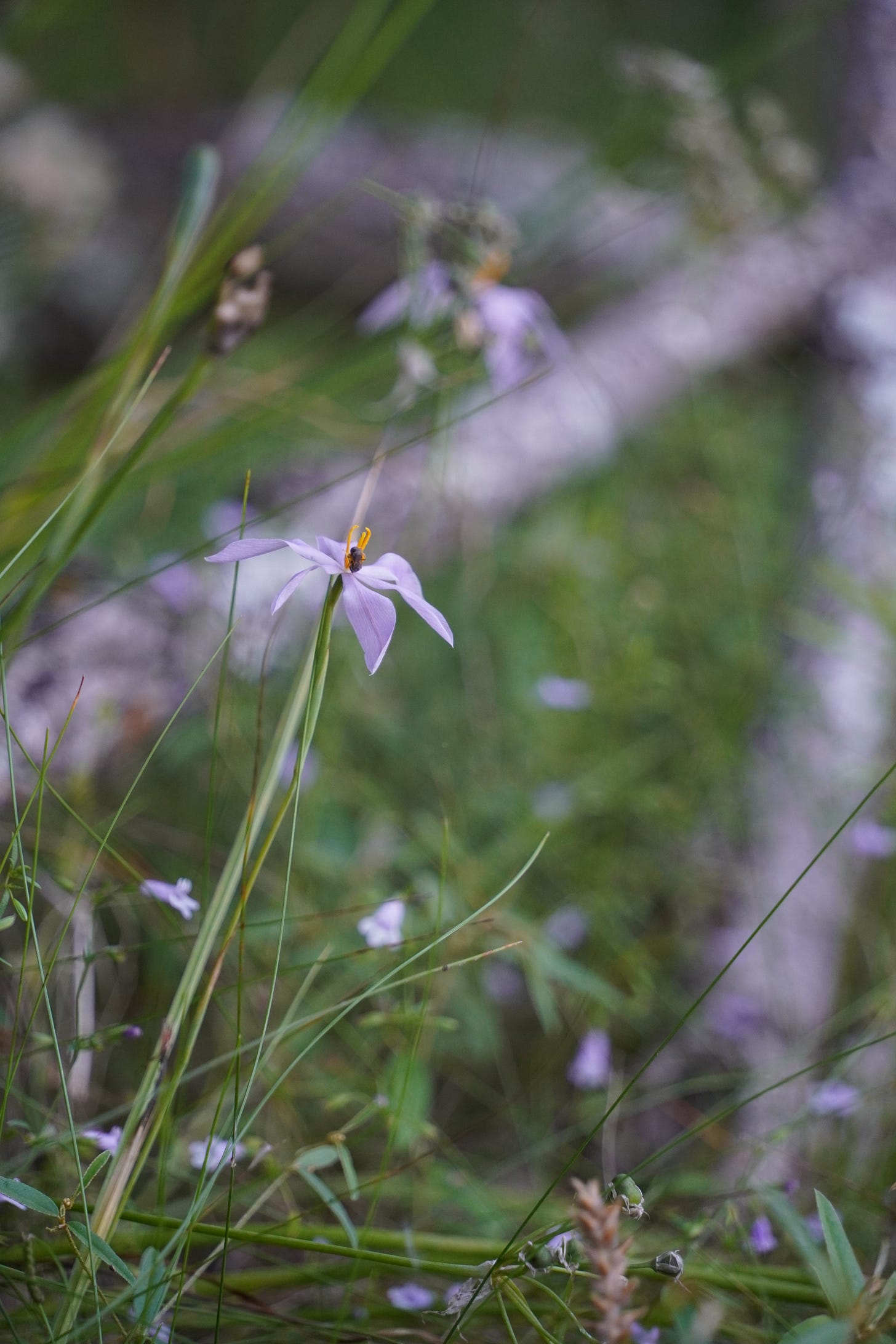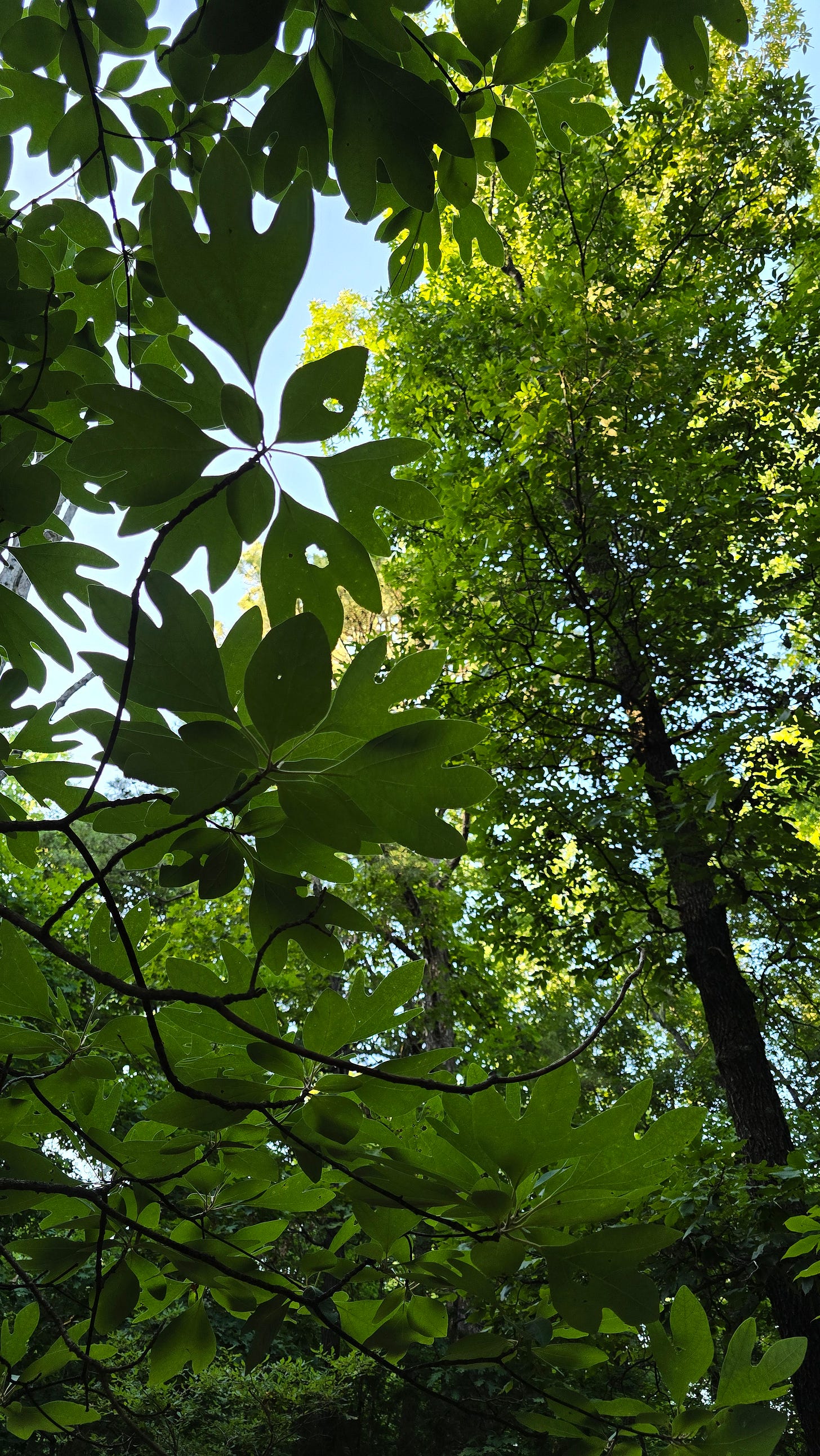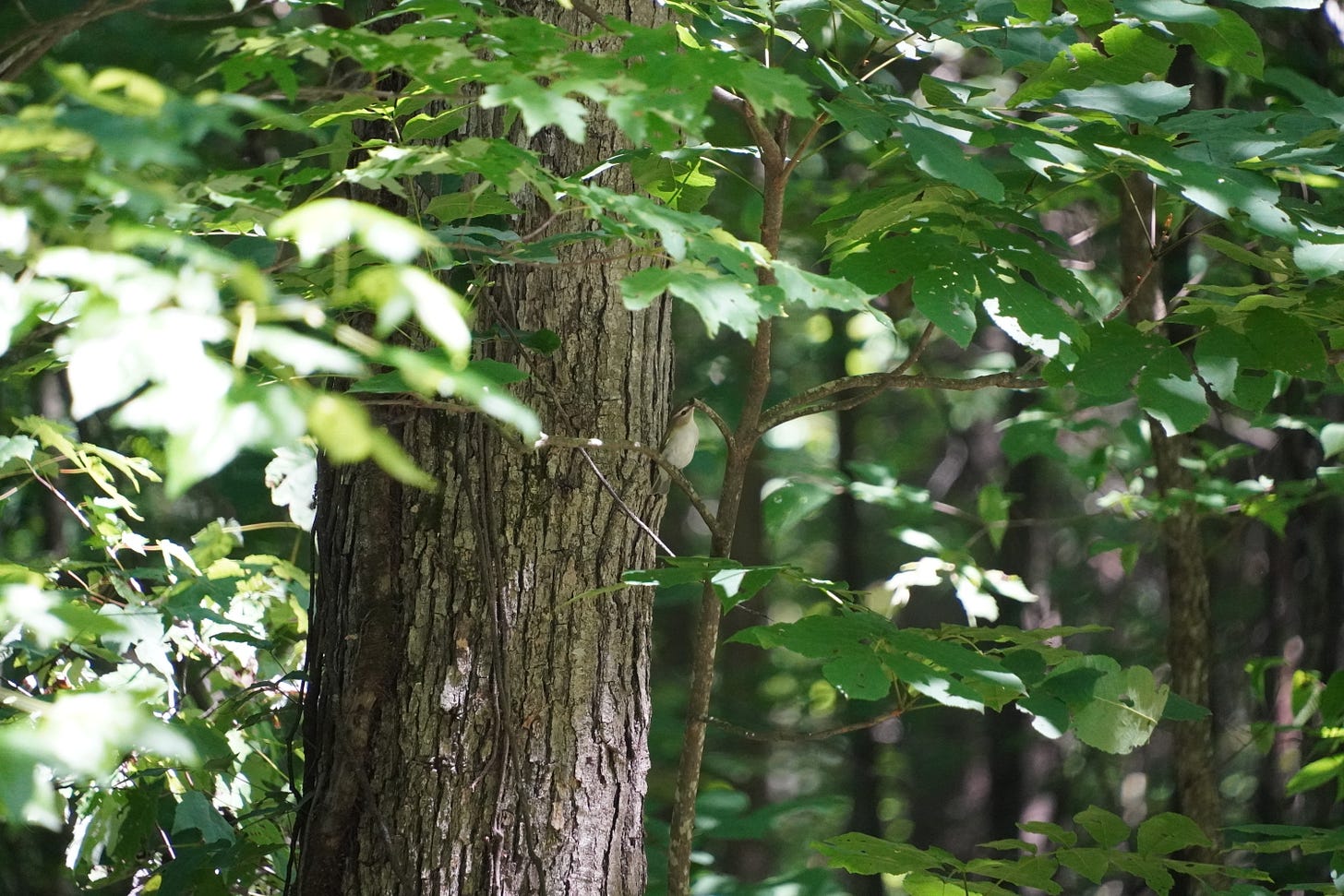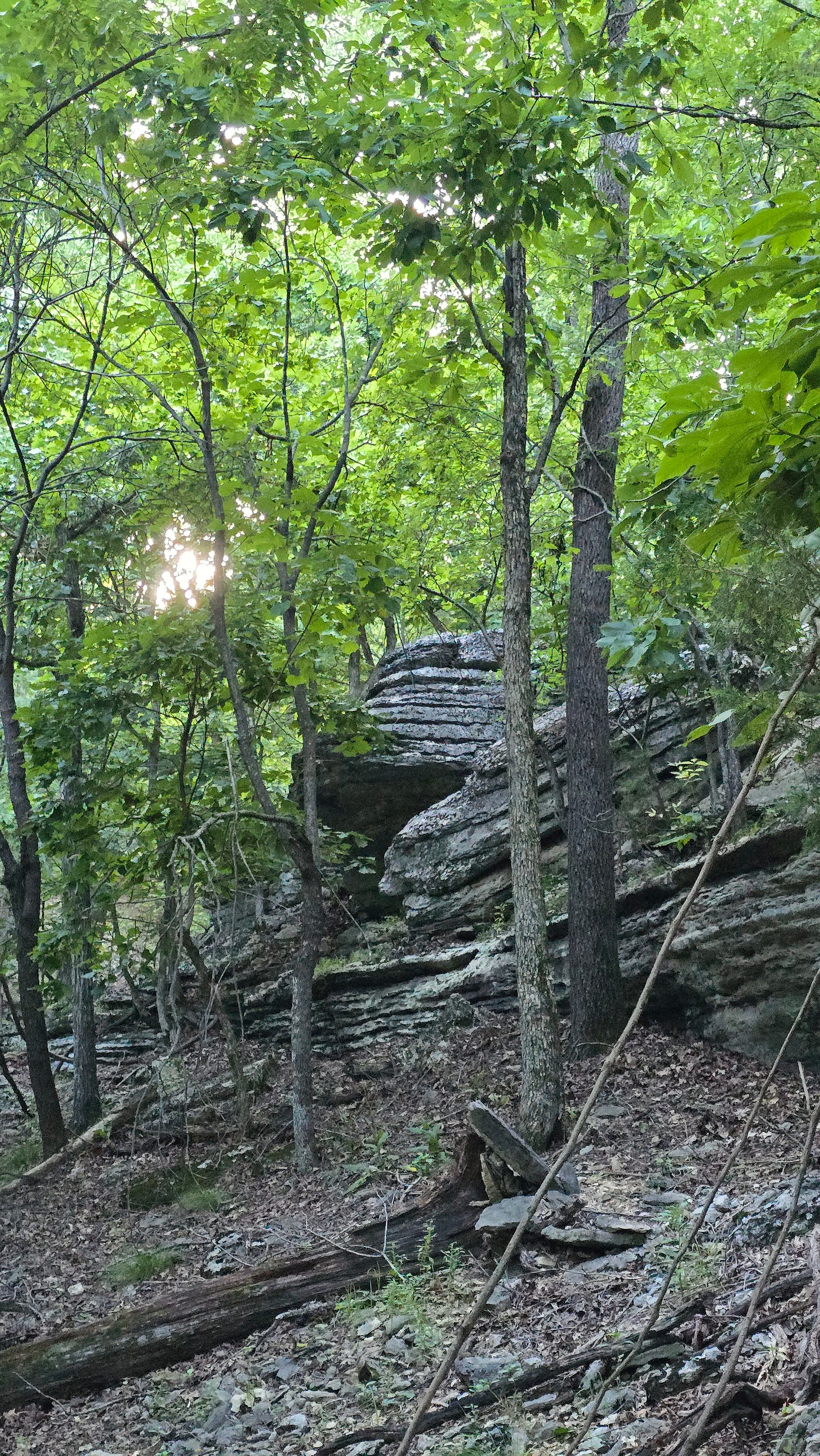Celestial Lilies and other Accidental Angels // June 2025
There are simply some days where you are suddenly gripped by an absolute need to go outside and be anywhere else but home; during one such evening, I felt compelled to go somewhere unusual. Normally, I take a short drive to walk up a gravel road to an old cemetery and sit under a giant Catalpa tree, whose leaves are currently covered in sphinx caterpillars. Somehow that didn’t feel like what I needed. I needed to walk somewhere and stay moving, not hold still in a place ensconced by cedar trees that block out the light and sound of the rest of the world.
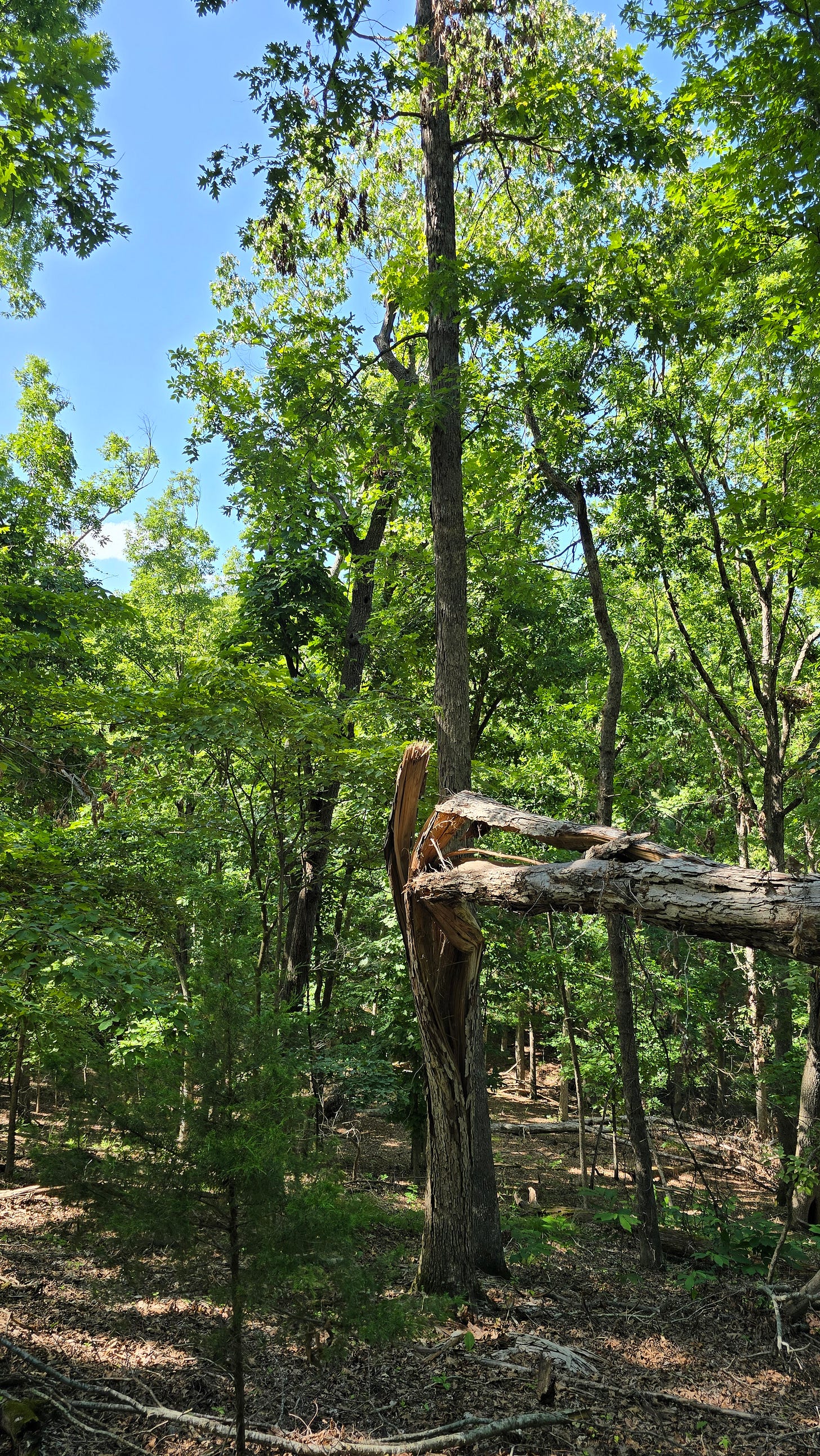
So, that evening I instead figured I might as well go see what a glade I’ve only been to in the winter looks like in the growing season. It is home to an uncommon lycophyte, Selaginella rupestris, but otherwise there seems little— in my memory, at least— to distinguish it from any other wooded hillside.
Reaching the glade requires a bit of patience. Park along the street or in a further-off trailhead parking lot, walk an eternity down a paved road, then turn and dive straight into the forest. The fastest way to go downhill is to follow a drainage, where you will be accompanied by gnats, noseeums, and small mosquitos.
The broad trunks of dead Post Oaks are everywhere in this forest, like so many other places around. A more mesic set of species seem to be doing just fine around these snags, aside from some Black Hickories and things of that nature.
After a long tromp downhill, you finally begin to see water. Cedar trees line the edges and block out much of the view, although speckled between them very occasionally are the charming leaves of very young Blackjack Oaks, both species capitalizing on the suddenly increased available sunlight.

There are even more cedar trees in the water itself, skeletonized Junipers ripped off the shorelines by rising tides, bleached by sun and discarded whole. More or less every edge of Beaver Lake is loaded with their bone-like trunks turned sideways, either floating or washed up on the shore.
On the shoreline, some fifteen feet or so from the edge of the water— currently at an unusually high level, some of the highest I’ve seen in my lifetime— the flora completely shifts. After a half an hour shuffling through leaf litter with very few herbaceous plants growing below, there is sunlight and a layer of wildflowers and grasses…. and even some snakes.
Hissing, rattling his tail, and throwing quite the scowl at me, this little snake did scare me for a few seconds— I reached down to look at a row of wild onions that were growing just on the other side of the trees, only to realize I had inadvertently stuck my hand within inches of his face. It was, understandably, a move not well-received. The rattling made me recoil, and my mind churned for a few moments trying to figure out what it was. On the edge of a lake with a dark pattern, it could only make sense for it to be a cottonmouth, yet it so clearly was not. Once the panic subsided and I relaxed a bit, I approached the snake again, and could see the breadth of its bizarre face.
The first hognose snake I’ve ever seen.
I had come out here in the hopes of ambulating and ruminating my way into some sort of insight on several things in life, the way that these things normally come to me while sitting in ‘my’ cemetery. Life has a funny way of giving you what you need instead of what you want.
I needed not to intellectualize the absurdity of human existence, but to feel excited about something again, to experience something new, to remember that love exists and that I do still care deeply about things… and here I was seeing the first hognose snake of my life, a species I have desperately wanted to see for so long. They’re supposed to be common, yet it is the only snake species not crossed off of my life list…. until now. It all came together, and the resultant enthusiasm of that alone could’ve carried me through the rest of the evening.
The snake had zero interest in moving, not even once I circled it and went back to looking at the plants surrounding it. Every now and then, it would hiss at me, and I would glance over to watch it visibly inflate with air.
Although many shorelines along Beaver Lake are composed of sand or gravel, these were simply exposed bedrock shelves with occasional patches of dirt and plants that had entrenched their roots within them. These are glades, and although they likely spent most of their existence kept open by a combination of fire, larger herbivores than exist today (perhaps elk; this area is far too steep for buffalo), and soil factors, today they are kept open by the waves hitting the shoreline, with its rising and falling tides. As wake boats blasted by at short distance, accompanied shortly thereafter by lapping waves, you can watch that alteration in miniature.
At this first opening, the plants were pretty typical. Beyond the wild onions were senescing Widow’s-cross Sedums (Sedum pulchellum), the narrow Pitcher’s Stitchwort (Sabulina patula), various plantains and other weedy things like that. On these opening glades, the rounded leaves of Prairie Tea (Croton monanthogynus) were common, although they disappeared on the higher elevation glades, instead being replaced by their narrow cousin Michaux’s Croton (Croton michauxii).
There were tons of a strange vegetative plant around, which I eventually realized, once I walked long enough to find one of the several hundred around that happened to be in flower, were Spanish Needles (Palafoxia callosa).
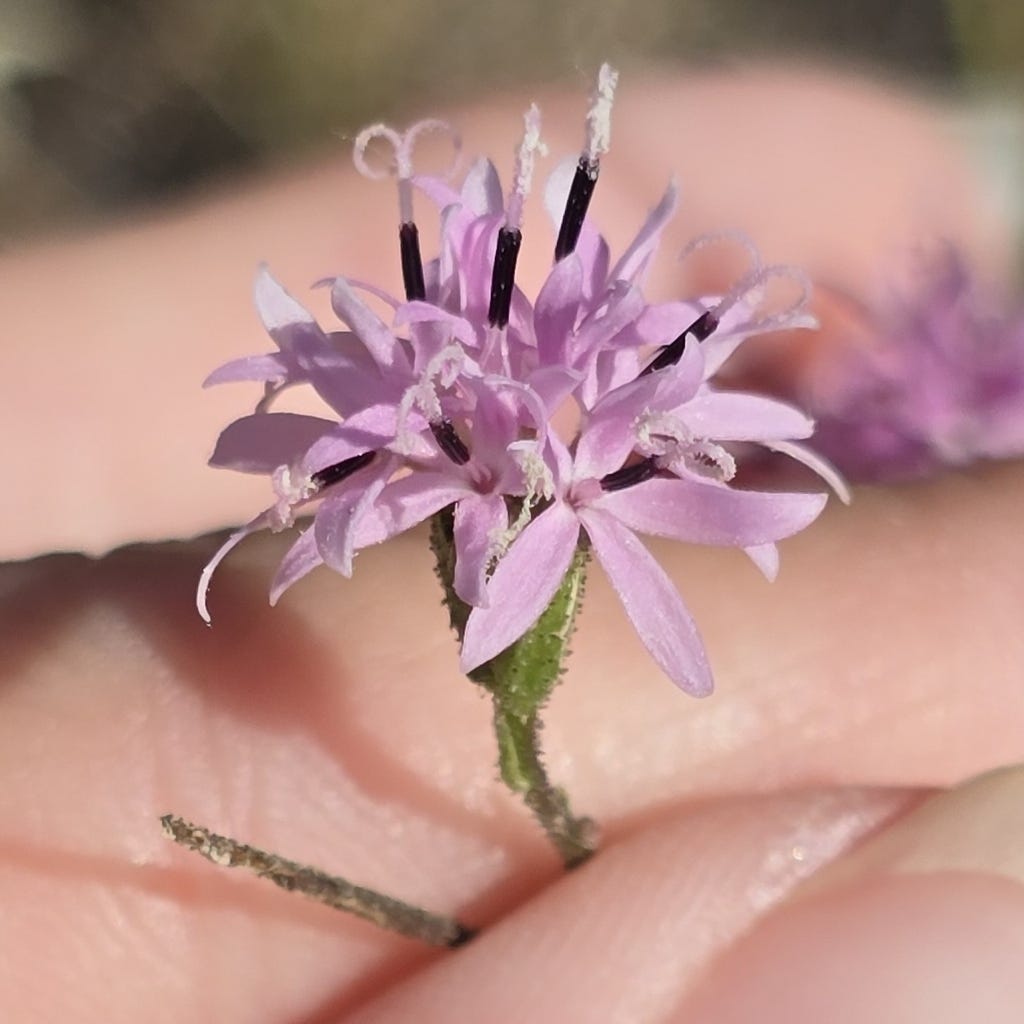
Like any other glade, the area was home to a broad variety of weeds. Many were of the invasive variety— Chinese Bushclover (Lespedeza cuneata) was perhaps the most prominent plant around, which is odd considering it’s a lot less common on glades than in other habitat types. Of course, it can basically grow anywhere; I’ve seen it growing out of the top of an awning in Little Rock, as well as the gutters of more than a few buildings.
Most of the other invasives were fairly minimal in presence. I did see a lot of Piedmont Bedstraw (Cruciata pedemontana), a deceptively-named plant that looks awfully similar to our more moisture-loving Galium species. Although there is a Piedmont Plateau out east in Appalachia, this plant’s name is in reference to the French Piedmont.
Plenty of the ‘weeds’ around were native species, however. There were a couple of Obi-wan Conobea (Leucospora multifida) plants around, sometimes in flower, and plenty of Rough False Pennyroyal (Hedeoma hispida), a narrow mint with pagoda-like stacks of flowers ringing its stem.
Another purple-flowering plant was also dominant: Arkansas Calamint (Clinopodium arkansanum). Besides being beautiful in flower, the thick colonies of this tangling plant entrench your hiking boots in a deep fragrance of mint. When I got into my car hours later to go home, all I could smell was the air conditioner whisking the scent up off my feet and circulating it around the cabin.
The most obvious glade species around also occasionally graced these rocky ledges, that being the prickly pear cactus.
Our native cacti are just as intimidating and painful to physically encounter as any other cactus. Below the larger spines are dense rows of glochids, tinier spines that easily embed themselves in skin and are difficult to remove.
Honestly, I’ve developed a mild irritation towards them from doing fieldwork in the Oklahoma Ozarks— on more than one occasion I’ve squatted down to look at something else, and a prickly pear hidden below some encroaching vegetation has stabbed my leg and sent me straight back to standing upright.
At least these cacti had little babies growing out of cotyledons. I can almost forgive them for their brutality.
Colors quickly began to appear as I traversed the lake-scoured glade. Little magenta dots speckled the bedrock, easily recognizable at great distance by their particular jewel tone. There ended up being two different types of fameflower (Phemeranthus spp.) around here, one with larger flowers about an inch in diameter, another closer to a quarter of an inch. These native succulents are even more adorable when they have miniature flowers.

A paler pink appeared shortly thereafter: the larger flowers of some type of meadow-pink or rose gentian (Sabatia sp.). I assumed these were Sabatia angularis since they were small and branching, but the bracts are too long, so… someday I’ll come back and decide what to call these.
Standing tall above the rose gentians was the ghostly and ominous spike of the Spring Ladies’-tresses Orchid (Spiranthes vernalis). For a few minutes, I thought that was the plant I had least expected to see out there.
Leaning off the edge of the lake, there were several spikes of Texas Toadflax (Linaria texana, formerly Nuttallanthus texanus) in seed, some linear-leaved Dichanthelium grasses, an occasional Buttonbush (Cephalanthus occidentalis) in flower, tiny daisies from a fleabane (Erigeron sp.), and even a few Coreopsis flowers casting sunshine-like rays over the water. A stunted Post Oak was barely surviving on that wet edge, undoubtedly unhappy about the moisture piling up from the unusually high lake levels. There were quite a few more fameflowers around this edge, and when I stopped to photograph one of the small-flowered species, I spotted a little patch of Selaginella rupestris embedded amongst some Grimmia and Hedwigia mosses.
The main novelty of the first lake edge was a strange Sedum with yellow flowers. There is an invasive species that I see around fairly frequently, particularly in riparian areas. I assumed it had to be that at first, but I noticed that it wasn’t stringy and crawling like that one is. They were all growing quite upright.
Some were falling out of the little pockets of soil, so I picked one up to look closer at the leaves, which were quite clearly not those of Sedum sarmentosum, the invasive one.
What’s really funny is that I had just seen Yellow Stonecrop (Sedum nuttallii) a few weeks prior for the first time, so there was obviously the thought in my mind that that was an option. However, I had looked at the range map the other day. Not a single post of it anywhere near where I live on iNaturalist, and I had even pulled up SERNEC and found no results for the species in Benton County. Nothing around here on there, either.
Glade Hopping Through North-Central Arkansas // 30 May 2025
It’s hard to begin this one— I can’t say what the target plant was, both because we didn’t find it, and also because I don’t want to give any hints about the location of something rare. What I can say is this: all of the other species of the day were infinitely more interesting than a variation on something I’ve already seen several times.
Of course, once I got home and looked into it at the end of the day, there appear to be records somewhere of the species in Benton County… and even Madison. Well, according to the Atlas. It’s most likely that there are vouchers somewhere that just haven’t been digitized yet.

It seems a bit unhappy with the conditions of the lake, but hey, that’s quite certainly what it is (and why it looks odd).
Walking up towards the main glades, which the lake never reaches on account of their height, required quite a bit of weaving in and out of the iron curtain of cedar trees that lined the edge. It was either that, or walking too close to the water for comfort— smooth, exposed limestone is the easiest thing in the world to slip on. It’s always an itchy and scratchy experience to shimmy past them in between the few gaps that are available. At some point I made the mistake of sighing, and wound up with a scaly branch poking me in the mouth. It was funny, at least.
There were some interesting limestone boulders, irregularly rectangular in shape, that were fun to crawl up. A mild amount of scrambling shortens the trip significantly. One had a nice spread of the nearly-blue Southeastern Wild Rye (Elymus glabriflorus). Another had a baby Virginia Creeper (Parthenocissus quinquefolia) vine showing its unexpected habit of putting up two simple (sometimes heart-shaped) leaves before developing its usual five-parted, radially symmetrical leaves.
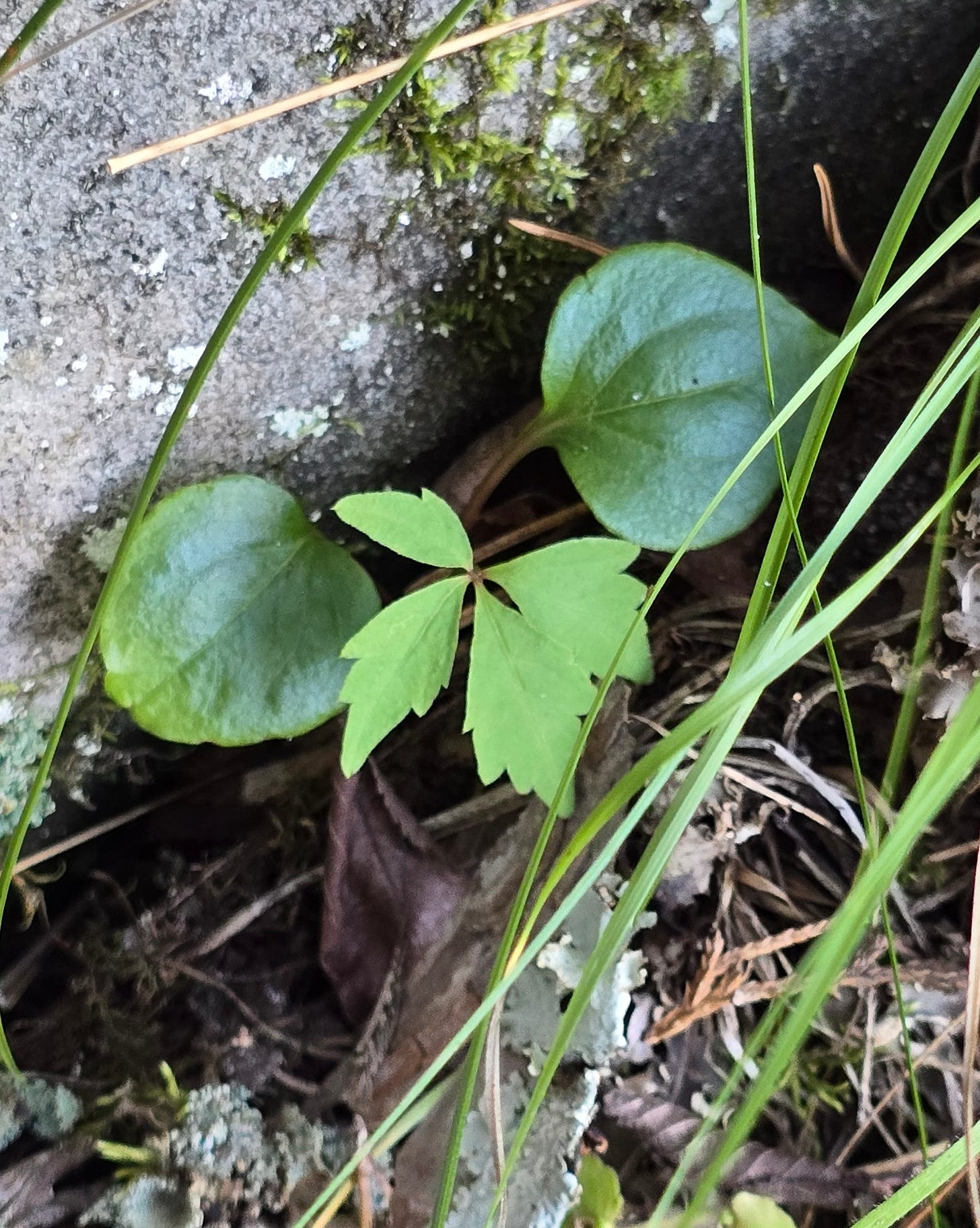
I passed a small opening thick with sapling Short-leaf Pines and a couple of Wooly Plumegrass (Erianthus alopecuroides), which I remembered from previous adventures out here in winter, and were orienting.
The lower area leading up to the higher glade has several towering pines that make it quite scenic.
Up higher, a Blackjack Oaks (Quercus marilandica) became more common than Post Oaks.
Some of the more southern portions, protected from the sun somewhat by the slope’s aspect as well as remaining cedar trees, enriched as well from a drainage that leads out over the edge and falls into the lake, have more mesic species like Eleocharis tenuis var. verrucosa, a spaghetti-like tangle of a sedge that loves wet areas and looks a lot like a grass, or Nodding Bulrush (Scirpus pendulus), another moisture-dependent species that is often seen in seeps and pond edges.
Further north, this glade appears to have possibly been burnt in addition to past effort to remove cedar trees, although the resulting flora is a little bit weedy and not diverse, especially in terms of species density.
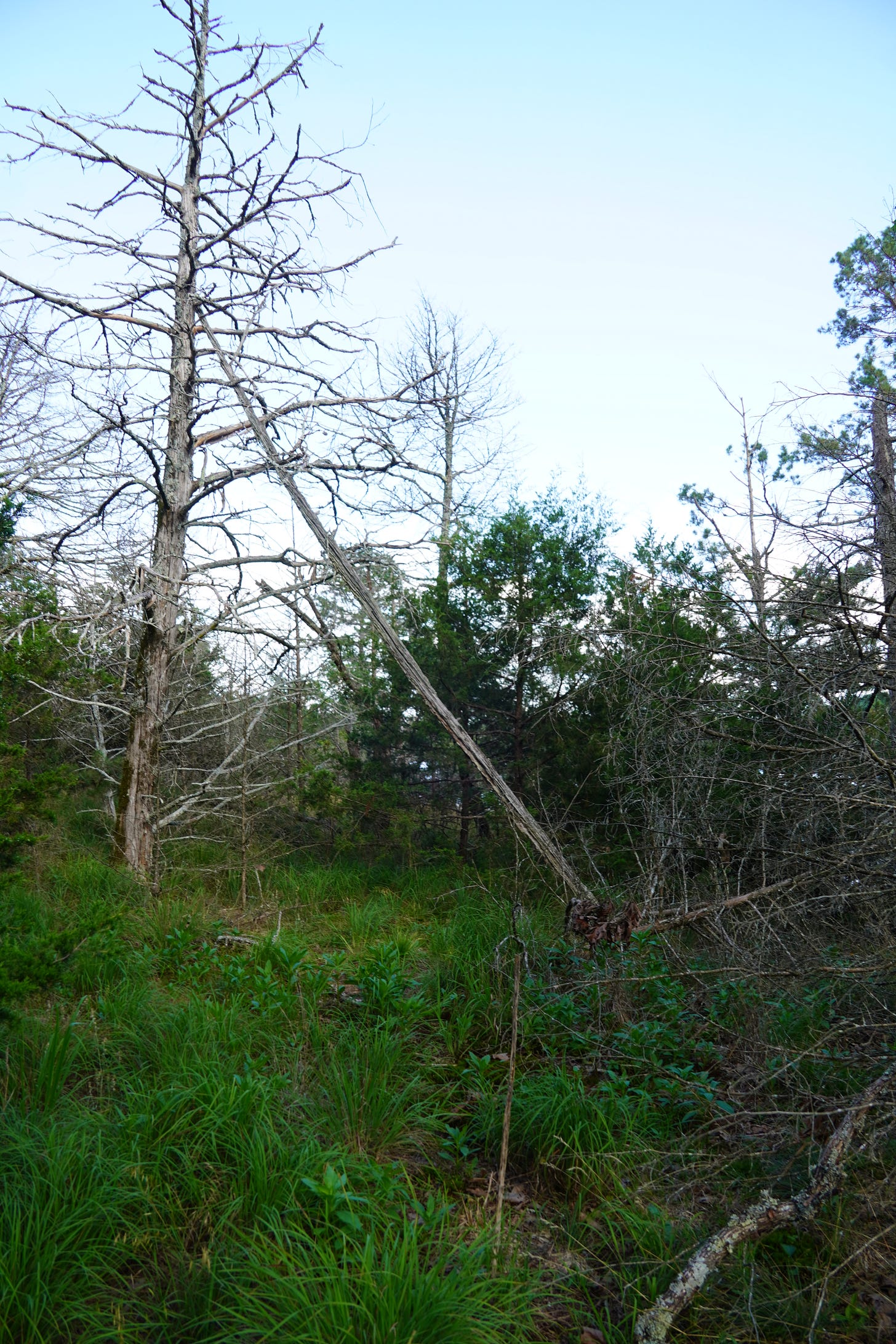
The largest colony of Pineweed (Hypericum gentianoides) I’ve ever seen smothered one part of the glade with little else between it. There was a nicer spread of monocots though, further ahead, with Fimbristylis and some interesting grasses appearing. Bracted Plantain (Plantago aristata) was also extremely common in the area, which always makes me happy.
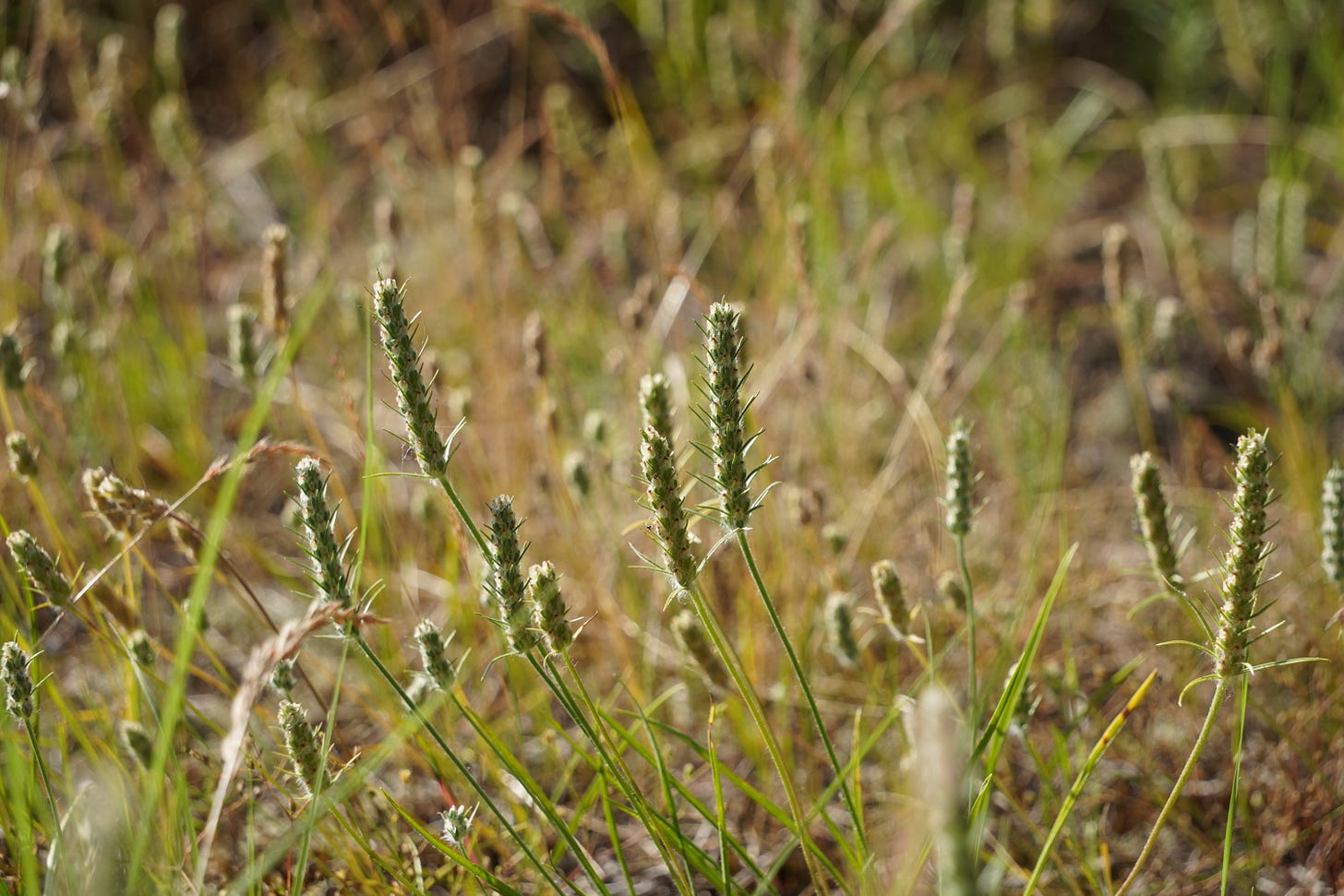
As above, so below; there are even more prickly pears up here.
It seems that the area that’s exposed to full sun up here has expanded since the last time I came out here.
Quite a few of the showy species from the lower lake-scour glades were present up here as well, albeit in reduced numbers. The Yellow Stonecrop was no exception.
The northernmost edge of the glade openings had a somewhat recently sawn off cedar on it.
There are several sections of glade that you can walk up before reaching a property line that’s quite obvious, courtesy of a swing hanging from a tree. Not far away is a massive Post Oak nearing the end of its life.
On my first trip out there, which I did not bring my camera for, I left that upper glade and walked the whole way back, coming out from a totally different spot. So much time had passed since I arrived that although the sun would not set for quite a while, a new regime of flowers would come out.
I noticed that there were no fewer than 3-5x the number of those small-flowered Phemeranthus in bloom on my walk back, but then I saw another time-sensitive plant, one I had no expectation of seeing anywhere, ever, except by deliberately seeking it out… and yet there was that distinctive shade of nearly-pink pastel purple, standing out like a sore thumb from the vibrant pinks of nearby Sabatia blooms.
Below the cedars, in the blend of shade and sun created by them, tiny flowers suddenly jumped out from everywhere. All I needed to see was that particular tone of purple to know they were Ozark Celestial Lilies, Nemastylis nuttallii.
There is no point in trying to use words to describe the immediate excitement, nor the impression it left on me.
Some people have a hard time picking a favorite plant; many refuse to even try. That… I cannot relate to, not at all.
My favorite plant is the Oklahoma Grasspink Orchid (Calopogon oklahomensis), a being of our western prairies with flowers in shades best compared to ballet slippers, and my second favorite is this pale purple wisp that often grows beside them: the Ozark Celestial Lily, formally known as Nemastylis nuttallii.
As for everything else, well, I'm not too considerate about rankings. Every other plant is an amorphous blob in the internal hierarchy of my mind.
Unlike the Calopogon orchids, this species is also present on glades. The habitat requirement for this tiny wild iris— yes, despite the ‘lily’ in the name, it is a different type of monocot entirely— is moreso lots of sunlight than a particular format of habitat which we could describe with terms like ‘glade’ or ‘prairie’.
These plants only flower in the late evening, and are pollinated by bees and moths. They love the sun most just before it sets, unfurling in the late-day partial shade, happily occupying a liminal space.
As I kept walking back towards my entryway where the hognose snake was, I walked past what felt like a hundred of them. The three-parted capsules that bear their fruit were everywhere interspersed between open flowers. It was an incredible sight.
I’d come here expecting little except a tiny lycophyte to look at, and been rewarded with a lush spray of flowers in every shade of pink to purple, not least to mention the dazzling sight of tons of my second favorite plant of all time.
I had thought I would sit on the edge of the lake and try to rationalize the senselessness of life, and received something far better. I had also come without a real camera… so I had to come back a few days later with my Sony.
This time, I parked on a spot I had seen on a satellite map that looked barren, being sure to look for any signs saying I wasn’t supposed to park there. There were none, so the access to the northern glades was quick, and I easily slid down the boulders towards the scoured areas. I’d gotten there just a little bit early to try to catch one of the celestial lilies opening.
There are neighborhoods both on the north side of this series of glades, as well as several across the cove. Although most of these are older, development around Beaver Lake has accelerated massively in recent years, and the constant building of new (and oversized) lake houses threatens many of these glades.
Thankfully, these are on land that’s owned by Hobbs State Park as well as the Army Corps along the water’s edge, so they’re protected from homes being built on them. However, those on private property are at risk. These are also at risk of increased degradation due to the increase in both quantity and size of boats on the lake, something certainly on my mind as I watched a wake boat drag a skier across the water whilst blaring “Me on You” by Muscadine Bloodline. Eroding shorelines seem to be a concern many fishermen in the area have had for years, and they apply to these types of habitats to some extent as well.
With an actual camera in hand, it’s easier to convey the strangeness of this habitat.
Soil exists in little clumps held together by plants and moss, forming little pincushions of life.
Other than that, the bedrock has little else but a crust of lichens and rock mosses on it. It’s surprisingly dark in color, despite surrounding rocks that are standard shades for chert and limestone.
The further back you get from the (current) shoreline, the more stable the vegetation is, unsurprisingly.
Once I found a nice patch of celestial lilies, I picked one out to set up my flimsy tripod on. Admittedly, I had absolutely no idea how to do a timelapse at the time; I simply hoped that if I took a bunch of photos, I could somehow figure it out later. Thankfully, it was easier than I imagined it would be.
A cute little nymphal stage insect joined me.
Funnily enough, the plant I chose was the last around to flower. I got to watch several other open in the background while waiting for this one to open.
I don’t know if my camera is synced to the true time that these were taken at, but the elapsed time should be the same either way; I started the photos around 6:25pm and ended at 6:40. Others opened in less time than this one, perhaps owing to them being in a fuller view of the sun.
It happens quite a big faster than you would expect. What was of particular interest to me was that the flowers visibly swelled just before the leaves began to unfurl; they started off as narrow tubes but quickly changed shapes all over, and did so before they even emerged from their buds.
Some sources erroneously describe the species as being pink or blue, but they are almost always a distinct cool-toned shade of purple. Some of the specimens I have seen in harsher lighting have a nearly pink tint to them, although I would say they’re at least on the cusp of purple in those situations, and it likely is owed entirely to the warmth of the evening light. There is a similar species, Nemastylis geminiflora, that has flowers that appear to be close to or decidedly blue— I’ve only seen photos of this one since it’s an eastern Ozark species, so it’s hard for me to say much with certainty— but it is obviously different from this plant in other ways.
Tiny native bees were busy feeding on the flowers. Someone on iNaturalist identified them as being members of the genus Lasioglossum, a type of sweat bee.
And of course, the next day I used some spare time to try and figure out how to make a GIF file out of the timelapse. iNaturalist accepts them if they’re small enough— emphasis on that file size mattering, and no, they don’t tell you if yours is too large when you try to submit it. After a lot of tinkering, I finally managed to get my timelapse up as an observation. Not to brag, but I think it’s pretty neat.
On the first day that I went down to the glades, I carried a chair and a journal with me.
At the top of the ridge, several Pine Warblers sang alongside a lonely but loud Yellow-throated Vireo.
Further down, the easily recognizable call of a Red-eyed Vireo began: Here I am; I am here. Where are you? Here I am.
I wrote that my anxiety delays my dreams, and admittedly I got a bit caught up in mourning things that are long gone… not that looking forward is necessarily the way out, because that can become a form of worrying, too.
Where are you?
Thinking about it made me remember, though, that nothing that has ever been good for me has ever left me. Only mirages, things I believed were good but wound up somehow being unimaginably corrupt, had disappeared, and I was left afterwards with nothing to show for them. Each time I failed to walk away first, failed to accept the truth that I was clearly recognizing as the situation dragged on, and that had been the whole source of pain in that latching on, the irrational aversion to loss.
Where are you? The vireo is utterly persistent, and I listen and respect that. Where am I? Stuck in the past, largely unwillingly. But I try to pull myself out of it, and this late in the process, I am able to come home to the present for a while. Here I am; I am here.
Sometimes, even in the sterile environment of a building in the city, I hear that call reverberating in my mind: Where are you?
And each time it calls, I try to answer.

